#AND WHY AFTER SEVERAL TIMES OF USING THEIR IMGS AS REFERENCES
Explore tagged Tumblr posts
Text





|| Alright, I no longer wish to work on this so screw the additional outfits I had in mind and all her gear LMAO. Even heavily referencing a model that ship nearly made me cry. Below the read more are more deets. I'M DONE OK.
Star Wars Verse
v. it's a trap!
Basic:
3/4 Zabrak so she has 2 hearts
Has 3 cranial spikes down the center of her skull
Slightly force-sensitive, she gets "gut feelings" and can sometimes sense a shift in the force. However, due to a lack of proper training, she doesn't have any real control over it
Mostly acts as a smuggler but dips her toes in bounty hunting and other occupations
Didn't draw them but she's got slightly elongated canines
Usually always has at least a blaster pistol on her but she's got an entire arsenal she'll use to get the job done as well as some kind of bladed weapon
Speaks several languages which i may have to come back an add
I have no set "era" for her so I'll kind of default to 31 for her age unless plotted/or planned out with someone
Top Left Img:
Very basic reference with a color palette
It's her typical get-up when she's working a job
The necklace belonged to her late mother. It's never taken off and she's not above killing someone if they try to take it from her
Serpent (made spacey for Star Wars) and sunflowers tattoo that's on her thigh. Depending on the friendship level she'll give different answers as to why she chose it
Top Right Img:
Two alt outfits she can be seen in
The first one is a more "casual" attire. Usually worn around the ship or if she's just walking around in public as a pedestrian
The second one is her "formal" attire. She is always happy to shoot up enemies in it
I had others in mind but I'm lazy so maybe I'll draw them at another time
Bottom Left Img:
Her companions!
Beans is some random creature I created. She got him from an exotic animal smuggler
Beans is about the size of a cat, I just wanted him to be visible
He has feet like a gecko and can climb most surfaces and a prehensile tail he uses to carry things around. He's also got pit organs like a snake on his snout to allow for infrared detection (species mostly nocturnal)
Dude is an R3 series Faye salvaged from a crash and modded with the help of a Mandalorian companion
He gives Faye a lot of sass but appreciates what she's done for him
Bottom Right Img:
Her ship is old in most eras but don't let it fool you, she keeps it in tip-top shape and has modded it so it doesn't fall behind
The Chimaera belonged to her late partner, Varyk, and she loves it to pieces. It is one thing that if insulted can get her fired up quickly
Her speeder bike is named after the Firaxan which is a species of shark in the Star Wars universe which is why it's painted the way it is
It's fast and her preferred way of getting around
#aurt#Faye#v. its a trap! [star wars]#I'm forgetting a lot i wanted to add#but im so tired I can't think#I will NOT be doing all this for the other verses lmao#maybe just alt outfits or something#snake imagery cw#snake cw
13 notes
·
View notes
Text
SONGS ABOUT LILY ON REPUTATION
The @whatiwillsay podcast is out now! Link. I joined Cam to discuss all things Rep album, including how gay it is and what was going on behind the songs. Here’s a guide to some of the songs discussed.
REP PROLOGUE
“When this album comes out, gossip blogs will scour the lyrics for the men they can attribute to each song, as if the inspiration for music is as simple and basic as a paternity test . . . Let me say it again louder for those in the back . . . We think we know someone, but the truth is we only know the version of them they have chosen to show us.”
DELICATE
This song was played after Taylor’s pride 🏳️🌈speech during the Rep tour.
Let’s start with Taylor straddling (“autostraddle” like the lesbian and bisexual women’s website) a Cadillac Fleetwood in the music video. (Source: internet movie car database (link); it’s not the Ford Thunderbird from the Kaylor Vogue photoshoot.) The Fleetwood could only match one person, Ms. Fleetwood herself, Lily Donaldson, great niece of Mick Fleetwood of Fleetwood Mac, who posted often backstage at their concerts and mentioned them in several interviews as her family. Lily’s mother is on the cover of one of the Fleetwood Mac albums.
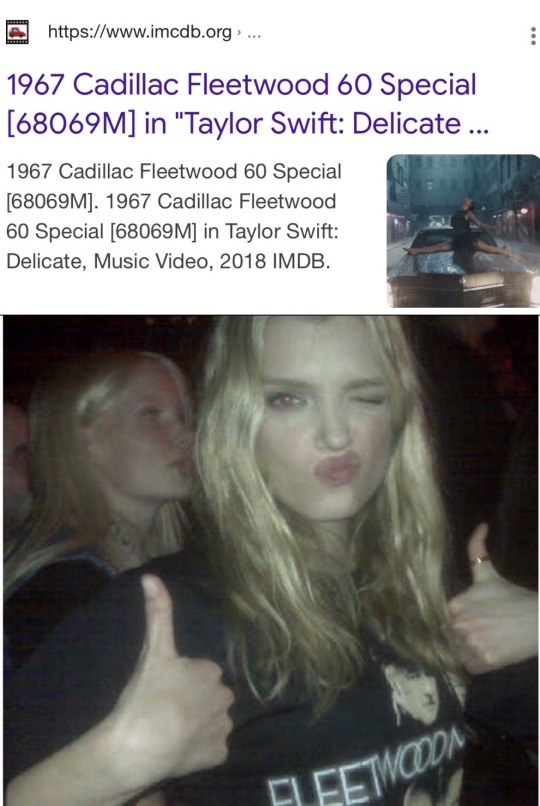
Let’s also talk about Taylor wearing the Victoria’s Secret angel ring in the “Delicate” vertical video, as well as the matching diamond eye ring that Lily also wears. Both rings were frequently paired with the J necklace during the Rep era.
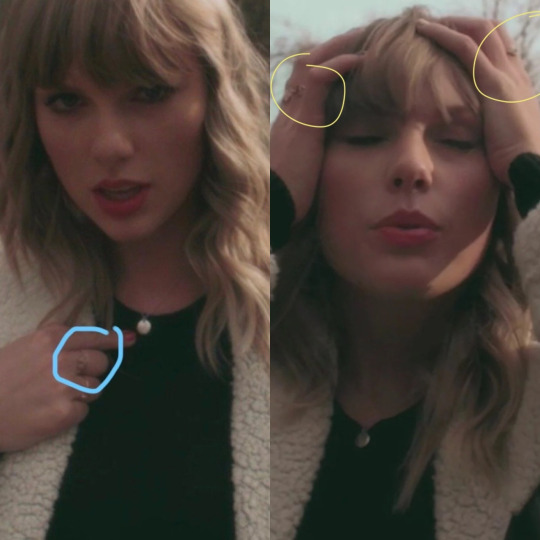
The Victoria’s Secret angel ring can’t be from Karlie or Joe. Karlie ended her VS contract by early 2015 per this article and this one too. She didn’t participate in the 2016 show where the rings were given out. Joe has no affiliation with VS.
The first verse of the song is a conversation:
“Dive bar on the East Side, where you at?” This is Lily asking Taylor to meet her at an east side dive bar. Lily lived in the East Village and was publicly known to like east side dive bars per interviews. Lily also lived just one block away from east side dive bars Lovers of Today and Cabin Down Below where Taylor, Lily, and others publicly went in October 2016. “Delicate” was written in October 2016 per the Making of a Song video.
“Phone lights up my nightstand in the black” - this is Taylor at home getting the text above.
“Come here, you can meet me in the back” is either meet at the back of the dive bar or meet at the back door of the Cornelia Street townhouse so no one sees.
“Dark jeans and your Nikes look at you” - Lily often wears dark jeans and sneakers.
“Oh damn, never seen that color blue” - a reference to Lily’s ocean blue eyes which will also come up in “Gorgeous” and throughout Rep, Lover, and Folkmore. (Karlie’s eyes are green/hazel per the fashion magazines and IMG Models - link, link, and link.)
“Third floor west side, me and you” - this refers to the Cornelia Street townhouse which was three stories tall and on the west side of Manhattan.
“Sometimes when I look into your eyes I pretend your mine, all the damn time” - why would Taylor have to pretend she is with Joe if the song is about him? She wouldn’t have to “pretend” they are together, they could just be together.
All the Taymojis for “Delicate” were blue, including the 🦋 which was the symbol Lily used for Taylor on social media and which also was the cover used for Lily’s Instagram highlights with Taylor during the Rep era. This symbol also became a big part of Taylor’s Lover era promo.
“Coney Island” - “did I close my fist around something delicate, did I shatter you?” “Sorry for not making you my centerfold.” This shows the “Delicate” relationship is over by Evermore (i.e. it can’t be about Joe) and the “Delicate” subject is a model who Taylor didn’t make her centerfold. Taylor made Karlie her centerfold often, including with the famous Vogue shoot, so this further leads me to believe “Delicate” and at least parts of “Coney Island” are about Lily.
END GAME
The London scenes (pub and kebab shop) where Taylor ends up at the end of the music video were filmed in Kentish Town, where Lily grew up as a child/teen and moved back to as an adult (see below). It’s within a mile of Taylor’s Hampstead (Frognal) place that she rented when she moved to London. (Taylor is seen in videos and photos wearing the Victoria’s Secret angel ring at Frognal here and here.)
Tokyo
The title card for the Tokyo scenes in the music video appear at 1:27, Lily’s birthday.

Lily was in Tokyo when Taylor was there filming the video in November 2017. The same doctor that confirmed that Lily was in Tokyo during the end of the Rep tour in 2018 (including photos of Lily), also confirmed that Lily was in Tokyo the week before Thanksgiving in 2017, the week Taylor most likely filmed in Tokyo based on her schedule (Rep was released on Nov. 10 then she had promo), Ed’s schedule, and known info about the various location shoots and post-production schedule leading to the early January 2018 release of the video.

This past week, Ed Sheeran confirmed in an Audacy interview (link) when the “End Game” music video was filmed. He said that his London scenes were filmed after he broke his arms because he wore a cast in the video. He broke his arms on October 15, 2017 in the UK. Taylor was papped on the streets filming the music video in London on October 16, 2017, so they likely filmed Ed’s London scenes sometime between then and November 7, 2017 when Ed gave an interview with the cast still on his arm in the UK. Ed posted on Instagram that his arms had healed and he went back to the Asian leg of his tour on November 11, 2017. For Ed’s Tokyo scenes with Taylor there are behind the scenes photos of Ed in a t-shirt and he is not wearing a cast, so the Tokyo scenes must have been filmed after Taylor’s Rep rollout promo which went up to November 15 (and while Ed was in Asia for his tour) but before Thanksgiving week when Taylor went to Utah. So that’s exactly the week the doctor posted on Instagram that Lily was in Tokyo. December was the filming of the Miami scenes on location (TMZ on set), Taylor doing the Jingle Ball, and post-production on the video.
A-Team
“I wanna be your first string, I wanna be your A-Team, I wanna be your end game.” Lily’s birthday post for Taylor of December 2016 likely referenced the A-Team phrase.
“Ooh, you like the bad ones too” could be a reference to Lily’s fling/situation/relationship with Rihanna (badgalriri), which was wrapping up in 2016 as Tily was getting started.
“It’s like your body is gold” could be a reference to Lily’s tattoo of the word “golden” in Latin on her left wrist, thus her body is literally gold.
“You’ve been calling my bluff on all of my usual tricks” is a similar card-playing, poker reference like in “Cornelia Street” (“back when we were card sharks playing games”).
GORGEOUS

“I got drunk and made fun of the way you talk” could refer to a British accent 🇬🇧 like Lily has.
“I got a boyfriend, he’s older than us. He’s in the club doing I don’t know what” is a reference to Calvin. This sets the timestamp for the song, while Taylor was dating Calvin, so sometime between 2015 and June 1, 2016 when the media reported that Tayvin broke up. As I’ve posted before, the Vanity Fair Oscar Party fits the song well. It took place at the end of February 2016. Taylor and Lily both attended this party. Karlie, Joe, and Calvin did not attend.
“Whisky on ice, Sunset and Vine” = Hollywood. Nothing is more “Hollywood” than the Vanity Fair Oscar Party. Lily captured the essence of the party with her post a few days before it featuring herself in front of the Hollywood sign, which is still up on her Instagram. (Link)
“You should take it as a compliment that I’m talking to everyone here but you” could mean Taylor was talking to her friends at the party like Lorde, Lily A., and the other VS models instead of Lily.
“Ocean blue eyes looking in mine” - we know who has these eyes, Lily. Not Karlie (who has hazel/green eyes per the fashion magazines and her management; see above) or Joe, who is referred to as “indigo eyes” in “I Think He Knows.”
Lyric video - the official lyric video (photo above; link) is in black and white except for the word “gorgeous” which is in pink throughout the video. To me this signifies that the gorgeous subject of the song is female.
Lily liked all three of Taylor’s posts about this song and none of her posts about other songs. It’s like she knows the song is about her and she acted like it at Taylor’s performance of the song in London during the Rep tour.
Is “Gorgeous” about pretty women in general? I don’t think so. The song has too many specific references (timeframe, accent, location, ocean blue eyes, etc.) to be about pretty women in general.
DRESS
“Made your mark on me, a golden tattoo”

Taylor wore a golden heart tattoo around her neck several times in October 2016, including during one of the Bowery nights, for the Making of a Song video for “Delicate,” and during Taylor/Lily’s painting date night.
Lily also famously has an actual tattoo of the word “golden” in Latin on her left inner wrist, her sister’s name. (See photos above.)
“I’m spilling wine in the bathtub, you kiss my face and we’re both drunk” - could be referencing the photos of Deadpool Taylor drinking wine in the bathtub on Halloween night of 2016. The October 2016 timeframe matches Taylor’s “golden tattoo” she wore around her neck and Lily’s almost exactly similar golden heart necklace worn around her neck on Halloween night.
CALL IT WHAT YOU WANT
The timeframe - after Taylor’s “cancelling” in 2016. “My castle crumbled overnight . . . they took the crown but it’s alright. All the liars are calling me one. Nobody’s heard from me for months, I’m doing better than I ever was.”
“My baby’s fly like a jet stream, high above the whole scene, loves me like I’m brand new” - this part of the chorus could be referencing “late November” 2016 referenced elsewhere in the song and specifically the Victoria’s Secret Fashion Show in Paris that Lily flew to right after Thanksgiving with Taylor. There are many photos of Lily on the jet or about to board the jet with Kendall, et al., and as we know Lily stayed “above the whole scene” and went immediately to London (where Taylor was at) after the Victoria’s Secret show with her snake jewelry in tow to wear to events starting in early December 2016. (See photos below.)

To recap the “late November” timeframe:
* Nov. 23 - Taylor wore the VS angel ring to see Todrick in Kinky Boots on Broadway. Taylor commented 13 🔥 emojis on Lily’s post from the Angel Ball.
* Nov. 24-25 - Taylor/Lily Thanksgiving in Rhode Island then flew back to New York. Taylor wore the VS angel ring throughout Thanksgiving.
* Nov. 27 - Lily took jet from NY to Paris for the Victoria’s Secret fashion show. “High above the whole scene.”
* Nov. 30/Dec. 1 - Lily snapchats from Paris doing Victoria’s Secret stuff including the fashion show and a photoshoot.
* Dec. 5 - Lily in London. Wears the Bvlgari snake necklace to an event for the first time. Lily spent the rest of December in London (confirmed via various social media) other than one trip to the U.S. Taylor was also now based in London per the Lover diary. At some point in December, Taylor took a photo of Lily, Cara and Suki in the kitchen of Taylor’s London house and posted it to Instagram in early January. (Link)
Taylor and Lily’s move to London in December 2016
The Lover Diary entry - January 3, 2017
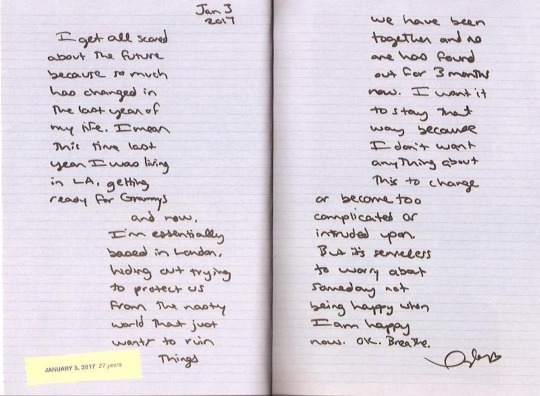
Taylor confirmed the start of the relationship with her London lover as being October 2016 (the Bowery nights, Lily’s snapchats and Instagram stories from Cornelia Street including up on the roof, the Delicate making of a song video with Taylor wearing the golden heart tattoo, the photo Taylor used for Lily’s birthday post of the two of them painting (which Lily said in an interview is a hobby she never shares with anyone; this article is also the second verse of “the 1” to me)) in this diary entry.
Taylor also confirmed that she and her London lover were now based in London, which there are many receipts of Lily moving back to London in December 2016, almost immediately after Thanksgiving at Taylor’s house (“I remember late November . . . would you run away with me?”). Lily’s Bvlgari snake jewelry first appeared on Dec. 5 in London. Taylor celebrated her birthday in London on Dec. 13. Lily is confirmed in London at that time and throughout the whole month other than a quick trip to the U.S. E! printed an article that said Taylor and Lily spent Christmas together. And the VS angel ring was everywhere with Taylor this month, including before Christmas, after Christmas, and in her Rep magazine photo for Dec. 29. (Tily December 2016)
Taylor included another photo from London with the Call It What You Want lyrics about running away together written on it in the Reputation magazine which came out in November 2017.

Taylor wore the VS angel ring in the Making of a Song video for Call It What You Want and in the video singing the song at her London house.
Lily got a place in Kentish Town in 2012 (per the Standard UK) that I believe she kept through the Tily years. Kentish Town is right by where Taylor first moved to in London.

Taylor’s move to London in December 2016 with the London lover is why the Rep muse (for most songs) cannot be Karlie. Karlie never moved to London. I’ve heard people say “the Lover diary is fake” or “Taylor didn’t actually move to London” but (a) if people can use the Lover diary to prove other things, it can certainly be used for this and (b) Taylor did move to London and so did Lily at the exact same time (if anyone wants to see receipts they are generally covered in the Tily Masterpost/Tily Nation version or just ask and I will be glad to provide them for you).
Could “Karlie, what you want” that many people hear, including myself at times, be Taylor asking Karlie, “what do you want to do” because Lily will move to London with me?
Callbacks to “Call It What You Want” in “Renegade” - “windows boarded up after the storm” and “starry eyes sparking up my darkest night.” This leads to me believe that “Renegade” is about Lily and takes place after Taylor’s “cancelling” in 2016. Also, the sirens in “Renegade” start at 1:27 (Lily’s birthday).
KING OF MY HEART
Model reference - “Now you try on calling me, baby, like trying on clothes.”
British references 🇬🇧 - “Salute to me I’m your American Queen” is sung twice in the song. “Say you fancy me, not fancy stuff.”
Female reference - “Cause all the boys and their expensive cars, with their Range Rovers and Jaguars, never took me quite where you do.” If the song was about a guy, it would have said “cause the other boys . . .”
Queer reference/keeping secrets - “Late in the night, the city’s asleep, your love is a secret I’m hoping, dreaming, dying to keep.”
Plural schoolgirls = two women - “Is this the end of all the endings? My broken bones are mending with all these nights we’re spending up on the roof with a schoolgirl crush.” They both have a schoolgirl crush, not just Taylor. Being up on the roof harkens back to the video of Lily on the roof at Cornelia Street from October 2016, the same month Taylor says in the Lover diary her relationship with the London lover started.
“Up on YOUR roof” - the original lyrics from the Making of a Song video are “up on YOUR roof” not “up on the roof.” Lily’s building had a roof for hanging out. Karlie’s building and Joe’s house did not. (Link)
Bonus - Taylor wore the Victoria’s Secret angel ring throughout the Making of a Song video for “This Is Why We Can’t Have Nice Things.” (Link) As well as throughout the Making of a Song video for “Getaway Car.” (Link). Time magazine reported that Lily may be one of the robot girls in the “Look What You Made Me Do” music video. (Link)
161 notes
·
View notes
Text
Dazai, Surprises, and things Not Going To Plan
Aight I’m gonna do this. I’ve seen a lot of times people go “I think Dazai should fail at least once and know what it’s like to not have his plans succeed, because he’s way to headstrong and cocky about all that.”
Thing is, there’s two major points against this hot take:
One - what we can see from looking at the series as a whole, is that Dazai has had plans fall through more times than we’re probably aware of. This includes times when he has been able to fix the plan to make the situation succeed anyway, as well as times when he has failed entirely and completely.
Two - what we know of Dazai as a character, both by looking at the series as evidence, as well as looking at things Asagiri has said, and things that come up in the light novels. As well, an important source is the original, real life author “Dazai Osamu” himself, as the BSD character was based on him.
Both of these points feed into each other.
Okay. So. With that in mind, I’m going to start off with an easy one, which appeared first in manga chapter 24. And yes, for most main series things, I will be referring to the manga rather than the anime, since to me the manga is a more accurate portrayal of the characters and events.

[img: Atsushi saying “Oh no... then, is there any way to turn the tide, Dazai-san?” and Dazai responding, his mouth full, with three fingers up, “Sure, about this many, I think.”]

[img: Atsushi saying “Three?” while looking shocked. Dazai says “No? I meant three hundred.” while having a peculiar expression caught somewhere between very intense and staring into the middle distance. Atsushi’s reaction to this is very shocked, exclaiming “Three hundred?!” inset into the same panel.]
See, what I mean by sharing this specifically is that Dazai doesn’t just predict one scenario and assume things are all going to go according to plan. He looks at the information available to him and thinks something along the lines of “what are the many various things that people might do, in these sorts of situations? Knowing these people as I do, what should I expect of them?” and because he’s just so damn smart, and people tend to act in specific types of patterns, he’s usually correct and one of of his plans works, whether that’s plan number one or plan number two hundred and thirteen.
This tells us several things, and not just that Dazai is smart.
It tells us that Dazai plans for all possibilities, accepting that things are going to happen that would be out of his control.
It tells us that Dazai isn’t a perfect plan-and-manipulate kind of person; if he was, he’d only have one plan and people would fall in line with it.
It also suggests something else - something we see both in the real life author, and in various other times during the series. It suggests that Dazai has anxiety issues, because “plans out the same thing over and over and over again” isn’t the sort of thing that someone who’s confident in their planning skills would do. It’s something you tend to do more if you’re anxious (and/or bored, which Dazai is too).
We can see him having anxiety issues easily when we know that the real life Dazai’s life was full of references to this. I also have read about the man and read some of his works and as an autistic/adhd individual who was undiagnosed for over twenty years, a lot of the way he talks about himself feels familiar, so yes, I do see him as having that to contend with as well, and find it easy to believe that BSD Dazai is at the very least ADHD. The specifics are for individual research or another post, but in short: rejection sensitive dysphoria, hyperfocus or no focus, sense of time is out of whack, inability to regulate serotonin (the happy stuff). A lot of that results in - especially due to how society treats neurodivergent people - anxiety and depression. Given I see both Dazai as having the same thing at least in this case? And every time I’ve read a new thing about ADHD I go “oh, hey, that’s both me and (BSD) Dazai”? I’d say it’s relevant.
This neatly leads in to the next point-
Dazai has had plans completely fail in the past. In fact, one could say that they fuzzed up. (See what I did there?)
Dazai has also been surprised and undermined and people have acted against his assumptions since he was fifteen or even younger than that. He also hasn’t always had this in any of his plans.
When in the start of the Fifteen novel, he asks Mori why he hadn’t just killed him when he had the chance, and why he doesn’t still do so. Why he won’t just let Dazai commit suicide. As we see Dazai through Mori, we know that the reason for this is because Mori is a lonely person, and currently at this point feels that the only person who is fully in the same boat as him and who can understand him is Dazai - but for Dazai himself, this is something he hadn’t planned for! It doesn’t make sense to him!
We also see him surprised again later in the same storyline, when Chuuya says “Arahabaki is me.” Dazai had anticipated many things, but that was not one of them.
Likewise, when he was sixteen, I believe that when Dazai went out to get captured on purpose, he anticipated that he would be - but not exactly how. In the prologue to the movie we see him being shocked at the extent of the damage used to cover up what would end up being his capture.
And in the Dark Era novel... there are things that he anticipates (Ango’s status as a spy, from the moment he saw the wet/not wet things in his bag), and things he really doesn’t.
At this point, I find it important to point out that whenever I think of that series of events, a key moment that was changed in the anime was how in the novel, Dazai was the one who put Odasaku’s kids in the mafia’s protection. Think about that. Dazai trusted that his authority as an executive would be enough to ensure that these children would be safe. He never once predicted that Mori might sell them out in order to use Odasaku. I still believe that it wasn’t just the way Mori used Odasaku himself as a chess piece, but also broke Dazai’s trust, that caused him to hate Mori in the present day.
Because if you think about it in these terms, and this is very relevant to the topic here, Dazai would see things in this way: “If I had protected those kids better, or handed them over to someone who had no connections to the mafia at all, then they might still be alive, and so might Odasaku.”
Thought about that way, the idea of “Dazai needs one of his plans to fail in order to be made humble/to be able to see himself as part of the group” seems unnecessary and actually quite cruel.
He HAS had his plans fail in the past. Plans failing means people close to him dying, and him being the one responsible, because he orchestrated at least some of the events that led to their death/s.
Dazai’s reaction to his plans failing and to losing someone back then was to lose his cool and to admit that he doesn’t know what to do. Perhaps it’s necessary to point out that he may have grown older by four years, but he most likely doesn't know what he’s doing now all that much more than he did at eighteen. It’s by going through the events of canon that he starts to understand himself more.
Going back to the canon references in the manga, the continuation of that scene above has Dazai accept that things always change, and don’t stay static;
“Bu then, Atsushi-kun, the situation in war is never fixed. Even a sure-win strategy could turn into a bad move due to a slight change in situation. That’s why having intelligence is so important.”
So, as said before - he takes what he knows, compiles the data, and comes out with scenarios that could work, but doesn’t stake everything on any one plan.
In short, one of my ideas is that one of his superpowers is being able to bluff and make things up on the fly, but make people believe he wanted things to go that way all along.
Following on from that, we have a couple more moments in the following chapters that also have “shocked Dazai, experiencing something unexpected.”

This is right when Higuchi is reciting Mori’s offer of allowing him back to his old position. He had previously just stated that there were “too many possibilities” for what Mori might want to say to him - none were the suggestion of taking him back.
I’ve seen a few fics and meta go with the idea that Dazai truly doesn’t care which side he’s on, aside from the promise he made to his friend. That nothing is keeping him from “going back.”
I don’t think that’s true, because just looking at this face, where he’s had no opportunity to prepare himself for what is about to be said, Dazai looks distressed.
The mafia was where he spent the worst years of his life - and I’m not saying it’s the worst place for absolutely everyone (hot take: I feel like it’s the best place for some people, like Chuuya) but that it’s where Dazai was at his worst. Even if they had tried - and been able - to help him more, it’s likely that having moved on from that point, certain things from his past might even be triggers for flashbacks and bad depressive periods, and periods of self-doubt. This would also explain why he would have actively avoided people who he would otherwise have had nothing against.
He goes from this, to then being told that Q - who is an entire flashback in himself - is released.

[img: Dazai’s shocked face with Higuchi stating “The Boss.. has released “Q” from [their] confinement.”]
Tellingly, Dazai’s immediate response after this? Is to say “As if he’d do that.” He disbelieves what he’s just heard because it makes no sense to him. It doesn’t seem like the logical kind of thing that the Mori he knew would do.
This is important for the entire point of this post - the entire several chapters here, the episode, the conversation Dazai has here. It’s full of him explaining himself, how he works, and being surprised. Of people doing things that Dazai doesn’t expect. Things happening that take his 300 plans he’d had and make him later go for one of the riskier ones.
Because he then, after being assured that this is no joke, explains what Q is capable of. And only once he says that since they’ve been warned, they [the ADA] can plan accordingly, does he realise that when they’d said they’d come “for his protection” that this is what they meant. That he was already too late.
Again: think on that.
Another time that Dazai’s plans have been interrupted with something so entirely dangerous and unexpected, and he nearly loses people again.
I’m not joking - re-read or re-watch these scenes, and you’ll see that Dazai absolutely freaks out, going wide-eyed and running straight back to where Atsushi is, and I think I’m right in saying that it’s one of the few times in the entire series that we actually see him shout.

[img: Dazai, panicked and shouting for Atsushi, saying “Stop it, Atsushi-kun! Look carefully!”, the actual speech bubble cropped out.]
If Dazai hadn’t realised that Q was already there by that point, then the girls might have died. Atsushi would have been lost to his own despair of having killed his new coworkers, and feeling like he would never be forgiven, could never be.
We see how he places so much faith and potential on Atsushi, no just seeing him in a way as an extension of some of what Odasaku told him, but also for how Atsushi might help and change Akutagawa, who he had been unable to (another person’s meta points out the whys of this quite well). Losing Atsushi like this would have been heartbreaking for him, even if he didn’t die.
For someone who can make three hundred different plans with what information is available at least, coming that close to losing someone who is important to him is almost as bad as having lost them. The scenarios might as well go through his head when he’s trying to sleep, telling him if you hadn’t been there in time, then he would be dead. Or worse.
Another point to make her in relation to this is actually not coming from Dazai himself, but someone who I think is meant as a foil to him, in terms of intelligence and how they deal with it: Ranpo.
In chapter 56, which hasn’t been animated yet, in order to catch the criminal Ranpo uses underhanded tactics, as his own people (for him, his family) are at stake. In one page he states;
“I knew it from the start. A regular person can’t beat a special ability. Nevertheless, I will defeat you. Because - my comrades think I’m invincible.”
We then see him go from being surrounded by his friends and family in the ADA, to being alone, with the others being silhouettes behind him, out of focus.
I firmly believe that this is the same - or similar enough - for Dazai. He is, outside of his ability nullification, using his intelligence in the same way Ranpo is. He won’t let himself lose to anyone, not because he’s always so powerful that it’s easy for him, but because he can’t afford to.
The end of the chapter with him facing off against Q after Q had affected Atsushi has Dazai say “even I can’t afford not to play dirty” and in dealing with this particular criminal, Ranpo himself says something very similar, that he will let himself become like a demon if it means protecting the Agency. In this, I think that they’re very similar people.
In short:
Dazai needs to be brought closer to the people he should be able to trust (the ADA, Chuuya, Ango) by allowing himself to believe that they won’t judge him. Every time that he relies on someone else is a step forward with this. Every time his plans fail, he falls further into anxiety and the fear of being responsible for things going wrong, and people placing the blame on him, as he was the one to make the plans in the first place.
Perhaps to other people it might seem strange to see me say this, but I believe that Dazai needs to be weaned into the idea that people appreciate his presence before he can allow himself to fail in small ways. He needs to be able to accept that people like him before he can see failure as anything other than potentially catastrophic. And he needs to accept that people won’t blame him. Which will take a long time - both because of his past, and because if I’m right and he’s got ADHD, then the rejection sensitive dysphoria is always going to be there.
#bsd#bsd dazai#bsd stuff#bsd meta#please note there are minor spoilers for events that the anime hasn't reached yet
27 notes
·
View notes
Text

Shintoism and Shrine Maidens
Shinto (Way of the Gods) is a religion which believes in the existence of “kami”, often translated as “gods”, “spirits” or “essences”, referring to the energy or sacred essence which manifests in the form of rocks, animals, rivers and people. Kami is not seen as an entity separated from humanity or the world, rather it is seen deeply intertwined with all things whether they are living or inanimate. In the show, we see youkai of all forms and natures, some of them were even shown presiding over animals or places, which shows that indeed all things possess the “kami” within them, and thus can manifest powers and are capable of being corrupted. In the Shinto religion certain deeds can taint a person with impurity, which one should want to cleanse for their peace of mind and good fortune.
Miko (female shaman or shrine maiden) were women who displayed special “powers” or abilities such as being capable of speaking to deities or being possessed by spirits. In Inuyasha we see that some priestesses such as Kikyo, Kagome and Midoriko had strong spiritual powers, thus enabling them to fight youkai and purify people, objects and places. When Kikyo is given the Shikon no Tama, it is because of her exceptional power of purifying it, which means she was capable of changing its very essence, the “kami” residing within it. And here I assume (this is based on my understanding after researching the subject) that the purifying powers these women display are actually a way of them extinguishing the evil which tainted the divine essence of these beings/things and change them to a pure form, which is why when they purify an evil yokai (a being made of hatred) they completely disappear. Because the “purity” which should have originated it never truly existed.
When a woman became a shrine maiden, she underwent a ritual that resembled a wedding ceremony, for she became the bride of a kami that she was meant to serve. That explains why miko were shown to not marry a man in the show, for they were already married to a kami; however, it is important to notice that according to articles regarding the miko practice, there were more than one kind of miko, and some of them even married the priests of their shrines, it depends on the time period or the kind of miko they were.
In the manga, Kikyo says she wanted to kiss Inuyasha but never could, which can be explained by her being previously married to a kami. However, when she died such bond was broken, thus enabling her to be “free to hate and free to love” once she is resurrected. No such relation to the kami was ever mentioned in the manga, however, it is possible to see that priestesses had a strong connection to the “essence” and “energy” surrounding them. Kikyo is even shown removing a creature that was meant to take a man’s life but was otherwise invisible to the humans around them. Not only is Kikyo capable of seeing the supernatural, but she has a deep understanding of it, which is proof of the extensive training miko had to undergo from a very young age (mostly after the start of their menstruation cycle, although there is evidence that some started their training at the age of seven, as it seems to be the case for Kikyo and Kaede). To become a shaman, the girl had to learn the several names of the kami important to her village as well as their function, purifying rituals and even how to communicate with the kami and spirits of the deceased. Some acolytes were sent to the countryside to learn different local dialects so that the speech of the dead would not sound strange to those rural inhabitants.
Kikyo has clearly mastered a wide variety of spells, incantations and rituals to purify and fight off evil spirits and yokai. She also shows a great knowledge of plants and their usage, which makes her a very good healer. Seen as a figure of wisdom and power, the priestesses in the manga are often treated with respect and kindness, probably because they represented the kami and were believed to carry their will.
This analysis contains facts from papers and articles I have read regarding shintoism and miko, however, certain aspects of their nature were left out to better fit the fictional world of Inuyasha. It also contains my own interpretation, thus not to be used by anyone else.
Researches source: X, X X and X
Img.
#┈ ┊ Words carved in stone || ( headcanons ).#this headcanon is very long but very immportant#and besides it took me a long time to write#I had written another one but I deleted it and changed it a bit#hope you guys like it!
15 notes
·
View notes
Text
3 Cups of Coffee a Day: Why It Can Be Good for the Health
Can’t start your day without your favorite morning drink, coffee? We can relate to that!
A 2019 survey by Reuters shows that 64% of Americans drink (at least) a cup of coffee every day. It’s not uncommon for habitual coffee drinkers to consume more than a cup of coffee every day. Elsewhere, it has been estimated that US coffee drinkers consume about 2.7 cups of coffee each day. That is the highest it’s been in 6 years. That figure translates to millions of Americans drinking a staggering 400+ million cups of coffee each day or over 140 BILLION cups of coffee consumed each year! To say that coffee drinking is a national habit is putting it mildly.
<img class="tve_image" alt="3 Cups of Coffee a Day: Why It Can Be Good for the Health" width="351" data-init-width="239" height="351" data-init-height="239" loading="lazy" src="https://lh3.googleusercontent.com/-YwFsQxcAjQE/X0qa2uECqlI/AAAAAAAAARM/K1bDqt_ut7A-IUyQ46MT1E5N8z9lgw65wCLQBGAYYCw/s239-c/3-Cups-of-Coffee-a-Day--Why-It-Can-Be-Good-for-the-Health.jpg" data-width="351" data-height="351" style="" data-css="tve-u-1743b7c79c0">
Coffee Drinking: Is it Healthy?
One might think that drinking several cups of coffee per day is unhealthy, but you would be surprised. According to scientific studies, drinking 3 (even 4) cups of coffee daily is not only safe, it can also be good for you.
Why Drinking More than a Cup of Coffee is Good for You
Coffee Has A Dose of Antioxidants
Antioxidants are nutrients that protect healthy cells from oxidative stress caused by free radicals. Oxidative stress causes cell mutation that increases the risk of health problems, particularly cancer.
Coffee is naturally one of the richest sources of antioxidants. It contains even more antioxidants than wine, cocoa, and tea. Clinical tests show that a single cup of unprocessed coffee beans contain 1,000 antioxidants. The number of antioxidants multiplies by the hundreds during the roasting process. The general rule of thumb is that the lighter the roast, the higher the antioxidant content.
Drinking at least 2 cups of coffee every day lowers your risk of liver cancer, colon cancer, rectal cancer, and type-2 diabetes.
<img class="tve_image" alt="Coffee drinking is healthy Bona Fide" width="351" data-init-width="239" height="351" data-init-height="239" loading="lazy" src="https://lh3.googleusercontent.com/-HtFK3rhXuQA/X0qa2iQf-0I/AAAAAAAAARQ/PTkkiVK0IE4Hn38Ki5apQB-4S92Vb0OLACLQBGAYYCw/s239-c/Good-for-the-Health-drinking-3-cups-a-coffeee-a-day.jpg" data-width="351" data-height="351" style="" data-css="tve-u-1743b7c79c0">
Coffee Is Good for the Heart
One of the most relevant reasons why coffee sometimes gets a bad rap is that its caffeine content accelerates the heart rate. This means people living with cardiovascular ailments could have some negative effects with too much caffein. Therefore, they are discouraged from drinking coffee. Still, the risks of consumption of caffeinated drinks appear to outweigh their benefits, it's potentially safe to drink at least 3 cups of coffee even if you are afflicted with a cardiovascular ailment or if you are at risk of developing heart problems.
An Australian study found that caffeine from coffee starts affecting known hypertensive participants only after drinking 6 cups of coffee in a lab test. Previous studies show that limiting coffee drinking to 3 to 4 cups have no adverse effect on people with cardiovascular disease and may actually lower the risk of heart disease by up to 22%.
Protection from Progressive Diseases
Regular coffee drinking is thought to minimize the risk of Parkinson's disease by a whopping 80%. The combination of caffeine, antioxidants, and bioactive ingredients is estimated delay the onset of Parkinson's disease by keeping the brain healthy. These nutrients promote normal brain and nervous system functions while also boosting athletic performance.
Coffee could also decrease the risk of Alzheimer’s disease and other forms of dementia among the young and the elderly by 65%. The caffeine in coffee reduces brain inflammation that's associated with cognitive decline.
To date, more than 19,000 studies have been conducted to determine the health benefits of coffee drinking. According to Tomas DePaulis, PhD, a research scientist at Vanderbilt University's Institute for Coffee Studies, "Overall, the research shows that coffee is far more healthful than it is harmful."
Some Factors to Consider
Too much of a good thing can be bad for you however, but as long as you are keeping these factors in mind and erroring on the side of moderation, you can enjoy several cups of coffee each day without any guilt.
About Caffeine: We all have different thresholds for caffeine. In studies, some could only tolerate its effect after 1 cup of coffee, while others could go for three or more. A cup of coffee contains about 94.8 mg of caffein. As long as your body can metabolize your caffeine without obvious side effects and you’re mindful of your daily caffeine total, drinking more than a cup of coffee won’t negatively affect your health. Caffeine is also naturally present in other beverages - including chocolate and tea.
About Calories: Some say drinking many cups of coffee is fattening but that only depends on the number of add-ons you used to flavor the brew A cup of plain black coffee with no sugar contains less than 2 calories. It’s also worth noting that coffee, by itself, may suppress the appetite. It inhibits the release of ghrelin, a hormone that triggers hunger. Adding cream, milk, sugar, cocoa, and other flavorings could increase its calories and fat content. Taking coffee with sweet snacks could also increase your caloric intake. If you’re watching your weight, drink your coffee plain and black.
About Sleep Problems: If you’re losing sleep because of your coffee habit, perhaps you should consider the timing. The caffeine in coffee could disrupt sleep but only if you drank coffee a few hours before hitting the sack. Caffeine takes effect an hour after drinking coffee and the effect will last for a few hours. If you don’t want your coffee to get in the way of a good night’s sleep, do not drink coffee in the late afternoon (4 to 5 PM) or early evening (6-7 PM).
As you can see, drinking 3 cups of coffee is not bad for the health. In fact, it’s good for you! So, the next time you wake up in the morning, why don’t you go ahead and treat yourself to a cup of coffee? Or better, make that a sexy glass of nitro coffee?
References https://www.bbc.com/news/health-42081278
https://www.healthline.com/health-news/6-cups-of-coffee-a-day-is-safe-but-more-isnt-healthy#What-are-the-health-benefits-associated-with-coffee-consumption?
https://www.foodandwine.com/news/americans-drinking-more-coffee-ever
https://www.webmd.com/diet/features/the-buzz-on-coffee##1
https://www.beingpatient.com/coffee-prevent-alzheimers/
The post 3 Cups of Coffee a Day: Why It Can Be Good for the Health appeared first on Bona Fide Nitro Coffee.
from WordPress https://bonafidenitro.com/3-cups-of-coffee-a-day-why-it-can-be-good-for-the-health/
2 notes
·
View notes
Text
Previewing images in and out of SLIME REPL
As any Common Lisp coder knows, a REPL is an incredibly useful tool. It can be used not just for development, but for running all sorts of tasks. Personally, I don’t bother making my Lisp tools into executable scripts and just run them directly from SLIME. As such, any operation that requires leaving the REPL is quite inconvenient. For me, one such operation was viewing image files, for example in conjunction with my match-client:match tool. So lately I’ve been researching various methods to incorporate this functionality into the normal REPL workflow. Below, I present 3 methods that can be used to achieve this.
Open in external program
This one’s easy. When you want to view a file, launch an external process with your favorite image viewer. On Windows a shell command consisting of the image filename would launch the associated application, on Linux it’s necessary to provide the name of the image viewer.
(defvar *image-app* nil) ;; set it to '("eog") or something (defun view-file-native (file) (let ((ns (uiop:native-namestring file))) (uiop:launch-program (if *image-app* (append *image-app* (list ns)) (uiop:escape-shell-token ns)))))
Note that uiop:launch-program is used instead of uiop:run-program. The difference is that launch- is non-blocking - you can continue to work in your REPL while the image is displayed, whereas run- will not return until you close the image viewer.
Also note that when the first argument to run/launch-program is a string, it is not escaped, so I have to do it manually. And if the first argument is a list, it must be a program and a list of its arguments, so merely using (list ns) wouldn't work on Windows.
Inline image in REPL
The disadvantage of the previous method is that the external program might steal focus, appear on top of your REPL and disrupt your workflow. And it’s well known that Emacs can do everything, including viewing images, so why not use that?
In fact, SLIME has a plugin specifically for displaying images in REPL, slime-media. However it's difficult to find any information on how to use it. Eventually I figured out that SWANK (SLIME's CL backend) needs to send an event :write-image with appropriate arguments and slime-media’s handler will display it right in the REPL. The easiest way is to just send the file path. The second argument is the resulting image’s string value. If you copy-paste (sorry, “kill-yank”) it in the repl, it would act just like if you typed this string.
(swank::send-to-emacs '(:write-image "/path/to/test.png" "test"))

You can even send raw image data using this method. I don’t have anything on hand to generate raw image data so here’s some code that reads from a file, converts it to a base64 string and sends it over SWANK.
(with-open-file (in "/path/to/test.png" :direction :input :element-type '(unsigned-byte 8)) (let* ((arr (make-array (file-length in) :element-type '(unsigned-byte 8))) (b64 (progn (read-sequence arr in) (cl-base64:usb8-array-to-base64-string arr)))) (swank::send-to-emacs `(:write-image ((:data ,b64 :type swank-io-package::png)) "12345"))))
Note that the first argument to :write-image must be a list with a single element, which is itself a plist containing :data and :type keys. :data must be a base64-encoded raw image data. :type must be a symbol in swank-io-package. It's not exactly convenient, so if you're going to use this functionality a helper function/macro might be necessary.
Image in a SLIME popup buffer
Inline images are not always convenient. They can't be resized, and will take up as much space as is necessary to display them. Meanwhile EMACS itself has a built-in image viewer (image-mode) which can fit images to width or height of a buffer. And SLIME has a concept of a "popup buffer" which is for example used by macroexpander (C-c C-m) to display the result of a macro expansion in a separate window.
Interestingly, slime-media.el defines an event :popup-buffer but it seems impossible to trigger it from SWANK. It is however a useful code reference for how to create the popup buffer in ELisp. This time we won't bother with "events" and just straight up execute some ELisp code using swank::eval-in-emacs. However by default, this feature is disabled on Emacs-side, so you'll have to set Emacs variable slime-enable-evaluate-in-emacs to t in order for this method to work.
Also Emacs must be compiled with ImageMagick for the resizing functionality to work.
Anyway, the code to view file in the popup buffer looks like this:
(defun view-file-slime (file &key (bufname "*image-viewer*")) (let ((ns (namestring file))) (swank::eval-in-emacs `(progn (slime-with-popup-buffer (,bufname :connection t :package t) (insert-image (create-image ,ns)) (image-mode) (setf buffer-file-name ,ns) (not-modified) (image-toggle-display-image)) ;; try to resize the image after the buffer is displayed (with-current-buffer ,bufname (image-toggle-display-image)))))) ))
Arriving to this solution has required reading image-mode's source code to understand what exactly makes image-mode behave just like if the image file was opened in Emacs via C-x C-f. First off, image-mode can be a major and a minor mode - and the minor mode is not nearly as useful. slime-with-popup-buffer has a :mode keyword argument but it would cause image-mode to be set before the image is inserted, and it will be a minor mode in this case! Therefore (image-mode) must be called after insert-image.
Next, the buffer must satisfy several conditions in order to get image data from the filename and not from the buffer itself. Technically it shouldn't be necessary, but I couldn't get auto resizing to work when data-p is true. So I set buffer-file-name to image's filename and set not-modified flag on.
Next, image-toggle-display-image is called to possibly resize the image according to image-mode settings. It’s called outside of slime-with-popup-buffer for the following reason: the buffer might not yet be visible and have any specific dimensions assigned to it, and therefore resizing will do nothing.
Here's an example of how calling this function looks in Emacs.

The position of the popup buffer depends on whether the original Emacs window is wide enough or not. I think it looks better when it's divided vertically. Use M-x image-transform-fit-to-height or M-x image-transform-fit-to-width to set up the auto-resizing method (it gets remembered for future images). Unfortunately there's no way to fit both height and width, at least with vanilla Emacs. I prefer fit-to-width because in case the image is too tall, it is possible to scroll the image vertically with M-PgDn and M-PgUp from the other buffer. Unlike other image-mode buffers, this buffer supports a shortcut q to close itself, as well as various SLIME shortcuts, for example C-c C-z to return to the REPL.
That’s it for now, hope you enjoyed this overview and if you happen to know a better way to display images in Emacs, I would be interested to hear about it.
4 notes
·
View notes
Text
Discussion: Ticker

Occupation
Ticker sells secondhand wares – random tools and items that the Tenno can use to decorate their Orbiter. She shouts out advertisements for her shop if the Tenno is standing nearby, but she also hints to her real business: debt forgiveness.
Ticker collects Corpus debt dossiers and will sell them to any Tenno able to pay. By investing resources and credits, a Tenno can redeem a Solaris from their debt, freeing them from their servitude to the Corpus. In return, the Tenno receive the Solaris' debt-bonds, which are used as currency by some Fortuna merchants – allowing them to collectively repay the debt of the freed individual. Ticker stresses that the debt-trading operation is highly illegal and that the Corpus authorities will kill her (or, more likely, brain-shelve her) if she were ever exposed. This may explain why the other residents of Fortuna stay away from her shop and do not mention her.
After the Tenno has reached rank Old Mate with Solaris United and proven to Eudico that they are a true friend of Fortuna, the floor boss will reveal, among other things, that Ticker also smuggles families out of Fortuna (and perhaps also smuggles supplies into Fortuna – Eudico's wording is ambiguous). These are likely families that are targeted for full repo or brain-shelving due to severe delinquency on their debt. It is not known if Ticker takes the families off-world or simply to hidden sites on the Orb Vallis or elsewhere on Venus.
Personal
Ticker is flamboyant and self-confident, never hesitating to give out advice on how to live a fulfilling life. She speaks, like many other Solaris, as someone who has experienced too much pain in life, but she doesn't seem to dwell on it, instead emphasising personal growth in the wake of every tragedy. She is aware of the role she plays in alleviating, even slightly, the incredibly dehumanising system of debt-bondage the Corpus have instituted, and her outlook is a curious mixture of optimism and cynicism. Overall, Ticker demonstrates one of the more complex personalities among the Solaris.
Ticker's mother is dead, from an unstated cause. Her other family is not mentioned.
Ticker's debt-bond memory fragments portray a deep, long-lasting romance that was terminated when her significant other was brain-shelved. Although Ticker sold off almost her entire body to clear her partner's debt and buy a rig for him, he had apparently suffered damage from being shelved too long, both in functioning and memory, and Ticker was unable to resume the relationship. Although the story is deeply emotional for her, she does not seem bitter about either the romantic relationship or the loss of her original body, and will refer to both when talking with the Tenno.
Ticker seems to be good friends with Smokefinger and looks after him, as she mentions that she will often bring him food and remind him to eat when he gets engrossed in his work.
Ticker mentions The Business in passing, referencing his current occupation as an ecologist and wildlife expert, but it appears to be a segue to an unrelated thought on the importance of combating depressing and violent thoughts. Whether this is simply advice or a subtle commentary on The Business is unknown.
Ticker is sympathetic to Rude Zuud and her malfunctions, but in an interesting way. She mentions "all her invisible friends" – Chatter and perhaps other split personalities we have not yet seen – and then talks about a paranormal experience where Ticker's mother appeared to predict the time of her own death. This suggests an assumption that Chatter is a supernatural phenomenon, such as a spirit possessing or assisting Zuud. This is an odd assumption for Ticker to make, since we know objectively that Chatter and Rude Zuud's other issues originate from the Deck 12 incident and the loss of her sisters. There are multiple potential explanations – disassociation and hallucination due to the trauma of the event, residual copies or fragments of her sisters' consciousnesses due to the oneness of their minds and the abrupt nature of the disconnect, or even sensor and comms malfunctions as mentioned in her Corpus debt portfolio – and none of them necessitate a supernatural influence. It is possible that Ticker is not very close to Rude Zuud and is unaware (somehow) of the events in her past.
Interestingly, Ticker will sometimes mention the legend of Gara and the Sentient Eidolon, drawing inspiration from the battle.
Other
Every resident of Fortuna who the Tenno befriends will eventually open up and begin talking about the other Solaris, with a single exception in that none of them will talk about Ticker (Ticker will, of course, mention others, as noted above). In fact, the omission becomes conspicuous during Operation: Buried Debts. After the Exploiter Orb is killed and Rude Zuud gains closure, her mental trauma appears to be somewhat eased and she remembers her sisters, and the life they led in Deck 12 with the other Solaris. Eudico replies, "We've never forgotten. Me, Biz, Smokefinger… any of us." It's possible that Eudico was simply avoiding having to name every resident of Fortuna, but the fact is that she did name every resident we know, aside from Legs and the Ventkids (who were too young to have known Zuud before), Little Duck (who was possibly not present at Deck 12)… and Ticker. Coupled with the fact that she appears to be unfamiliar with the nature of Rude Zuud's trauma, it is a distinct possibility that Ticker was not present during the events of the Deck 12 crackdown. Since her accent points to her being a Fortuna native (unlike The Business), it is possible she was away at the time, working off her debt on a Corpus colony or ship elsewhere. Deck 12 holds such central importance in the histories all Fortuna residents that the fact that there are zero connections to Ticker is remarkable.
Another explanation, as noted earlier, is that the silence is a deliberate policy in place to protect Ticker from scrutiny, since she performs extremely dangerous work of great importance to the Solaris. Either way, a Tenno who never ventures into the upper level of Fortuna may never know she exists.
[Navigation: Hub → Discussion → Ticker]
32 notes
·
View notes
Text
Betty You Fool: GlitchTale Analysis

Featured: a fool with bad plans.
Note: The following article analyzes Betty's evil motivations and actions to explain how foolish it all is. In Season 2, Episode 5 of GlitchTale, Betty refers to Frisk as a boy once. Up to that point, Frisk is called a "they". As this article almost entirely focuses on Season 2 Episodes 1-4 with only a little Episode 5, it will adhere to episode Episode 1-4 customs.
In brief: Betty’s plans (or "villainy", in general) are ill-conceived and doomed to backfire on her. Supposedly, her goal is to ensure humans and monsters never live in peace, for a civilization where the two coexist would eventually threaten humanity’s survival. However, her goals are based on unfounded fears, and her motives are contradictory. Furthermore, trying to achieve her goal by killing all monsters quickly, with herself as the obvious perpetrator, and killing many humans (including children) for her plan, is just going to unify humans and monsters by giving them a common enemy.
Introduction
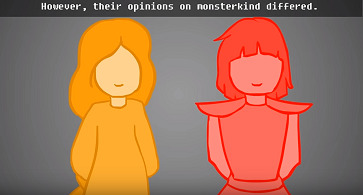
In GlitchTale, Bete Noire ("Betty") is a being said to exist for the sole purpose of ensuring humans and monsters never live in peace. Her creator was Agate, the Wizard of Bravery and one of the wizards who created the barrier. Her opinions on monsterkind differed from her brother, another wizard that helped make the barrier. While her brother wanted to destroy the barrier, Agate thought it a good measure to keep the peace. Agate challenged him over the fate of the barrier, lost the fight, and exiled herself. Later, she used a forbidden spell to increase her power, returned, and killed her brother. Dying from the spell, she used her soul and the corpse of her little sister (who she killed to weaken her brother) to make Betty.
Betty herself was released from the barrier itself when it was broken. Soon after she woke up, Agate “uploaded” her memories to Betty, and told Betty her purpose.1 Disguised as a sweet human girl, Betty befriended Frisk. She also manipulated Jessica Grey, head of the Anti-Monster Division, who wanted revenge on monsters after learning Asgore killed her missing child 20 years ago. Betty promised to Jessica to turn all monsters to dust (kill them). However, she later showed her true nature: when Jessica wouldn’t give her the hate vial (a noxious power-up), Betty tormented her with a gruesome illusion of her dead child and attacked her.
Jessica, having survived, turns against Betty very quickly. She apologizes to Asgore, asks for his help in defeating Betty, and gets him out of prison/jail to this end. This is all for her daughter’s killer, which shows just how drastically Jessica's beliefs changed. Jessica also cooperates with several other monsters to take down Betty, and gets many humans to team up with monsters as well. She even sacrifices herself so that W.D. Gaster, a monster, may live.
If Betty’s goal is to ensure humans and monsters never live in peace, she really messed up.
Betty's Ill-Conceived Motivations
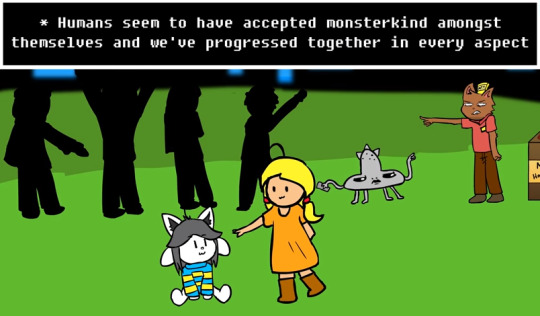
In roughly a month, humans adjusted very well to living with another species of sentient beings. From Season 2, Episode 1.
First, Betty’s beliefs are unfounded, and sometimes even contradictory. She (or possibly Agate) wants to “ensure humanity’s survival.” As she believes monsters are a threat to humanity, she wants to ensure the two never live in peace, or for that matter coexist.
Yet, as Frisk points out in the first episode of Season 1, monsters are harmless2: as of that episode, humans and monsters co-existed for about a month without any problems. Furthermore, integrating them into human society with more rights could only benefit humanity, increasing their likelihood of survival. (e.g., Gaster’s CORE expansion becoming a non-polluting, unlimited, self-sustaining power source that will make electricity free and blackouts a thing of the past)
Furthermore, if they somehow did turn hostile to humans, they couldn’t do much and they would be easy to kill off. As Betty knows from experience (and Agate might know from the war) humans are far stronger than monsters and can kill them easily, particularly since humanity as a whole massively outnumbers monsters now. Though Betty evidently believes a civilization with monsters and humans existing together “is just a time bomb waiting to go off” and “that [she is] doing good by speeding up the process”, in going through with her plan she causes problems and casualties where none previously existed.
It's possible Betty fears monsters would gain godlike power by absorbing seven human souls, just as the Waterfall plaques claim. Though the plaques also claim this had never actually happened, they then say humans attacked monsters out of paranoia they would take their souls. It is possible Agate told Betty about this, which is why Betty thinks monsters threaten humanity.
However, monsters living together peacefully with humans have no reason to do this, and might not even believe it possible so much as a myth humans made up. Indeed, if some monster went rogue and killed a human to absorb a soul, it's likely other monsters would team up with humans to take down the rogue monster.
Notably, Frisk went up against a god and won. If Betty only knew of Frisk's track record against beings with godlike power, she'd be even more eager to make Frisk an ally, just in case a monster did get seven human souls and cause the worst-case scenario humans evidently feared so long ago.
Betty's Plan is Doomed to Backfire
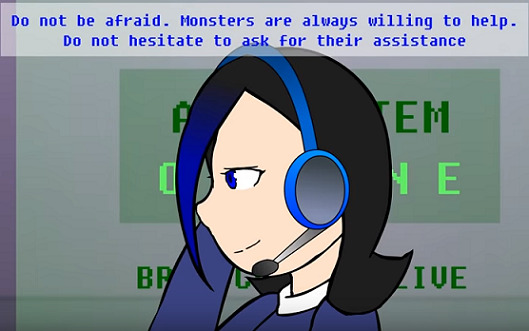
An example of cooperation: Jessica Grey, showing the extent of her reversal in beliefs.
Of all the ways she could operate on her (irrational) beliefs, her plan is the worst. First, she tricks a monster (Papyrus) into accidentally killing some humans by dropping metal girders on them. Sans (a monster) uses blue magic on the bars (represented as telekinesis) to try to stop them from landing on anyone, but Ms. Grey (secretly allied with Betty) disables his ability to use magic. The girders then crush some humans. Later, Betty's plan involves killing hundreds of humans (including many children) in a short time, to use their souls as a power-up so she can kill off lots of monsters very quickly.
Even if she’s evil enough to disregard the obvious moral issues of her plan, it would still have two problems. One, her aim is supposedly to “ensure humanity’s survival”, yet big parts of her plan are blatantly anti-human, and she makes herself a threat to humanity’s survival. Two, since she’s neither human nor monster, kills both, and makes it obvious she’s the killer, monsters and humans have very good reason to team up to kill her and, in the process, lessen prejudice between them. This would get them to cooperate more, increasing the chances of long-term peace between them.
Therein lies a contradiction: though her plans are supposedly for humanity’s sake, Agate tells her she can't trust humans, and Betty has no loyalty for humans. Betty evidently corroborates “humanity can’t be trusted” by seeing into Frisk’s memories (stated in supplementary material) and seeing their Genocide Routes. However, she apparently doesn’t check anybody else, and, if anything, wouldn’t she trust Frisk more for those routes if she hates monsters so much?
What Betty Should Have Done
If Betty were smart, she’d act like Batman. Batman is aware Superman is nigh-invulnerable, super strong, and has quite a lot of useful powers. Were Superman to turn evil for some reason, he would be a massive threat to other superheroes and perhaps all of humanity. Yet, Batman tempers his distrust/caution with evidence: Superman is very morally principled and (unlike some other superheroes) never kills.
So, rather than attacking, trapping, or disabling Superman immediately because he could pose a threat, or even just being mean to him, he acts friendly (by Batman standards) and secretly has a plan to take him down if necessary.
If Betty believes a civilization where monsters and humans live together is “a time bomb waiting to go off”, why not disarm the bomb? Wouldn’t it fall within her interests to solve inter-species conflict as much as possible, delay it as long as possible if diplomacy can’t solve it completely, and develop (proportionate) monster-killing plans in case of emergency? Even separating monster society from human society (which, by the way, would deprive humanity of monsters’ benefits) would be a better plan than all that murder.
Why Didn't She Do It?
The most likely cause for Betty’s irrational and contradictory behavior is: she’s an impatient, short-sighted, and probably also lonely species-ist who fears and distrust monsters for no good reason, wants to make her species-ist mother happy, and she doesn't consider that her creator or she herself could be coming to the wrong conclusions (e.g., checking Frisk but not anyone else afterwards). (Note that Betty, though not human, is still a child. It’s plausible she didn’t think this through.)
As far as can be inferred from the supplementary material; it doesn't have any dialogue or explanation. The interpretation was based on how TVtropes described it. ↩︎
In GlitchTale, it’s specifically stated that Asgore killed the seven fallen humans, who were all kids. Jessica Grey later visits him in prison; apparently he was in prison for killing those kids. ↩︎
58 notes
·
View notes
Text
Another Day in Paradise
Another Day in Paradise

by Robert J Lester IG: @mountain.king97
In the winter of 2017, I traveled with Joel Hiebert and Justin Hodges to Utah to ski in the Northern Wasatch. The goal was to summit and ski Ben Lomond Peak, a relatively unheard of mountain compared to some of the legendary peaks found farther south in the Wasatch Range. Ben Lomond Peak so happens to be the peak that Paramount Pictures modeled their logo after, which made it stick out. We wanted to ski the mountain that is shown before all those movies we had watched as kids.
While making our ascent, we noticed what seemed to be a tight couloir coming off the Southeastern side of Willard Peak, the peak just to the North of Ben Lomond. We instantly wanted to ski the line, considering canceling our current objective for this new mystery line. Although common sense prevailed, leading to a truly wonderful summit and ski of Ben Lomond, the desire to ski the new line burned deep inside of me.
Upon return, research into the unknown couloir of Willard Peak immediately began. Despite intensive efforts, no beta, trip reports, or even stories about the couloir were ever found.
In the spring of 2019, Joel and I decided that it was time to return to the Northern Wasatch for the line that had eaten away at us for the last two years.
Beginning long before first light, we made the same approach and ascent as two years previous. The plan was to summit Ben Lomond then traverse northward across the ridge that connected Ben Lomond and Willard Peak. Once we reached the summit of Ben Lomond, we met a local legend known for not only his local knowledge but also his impressive accomplishments. That day he was trying to accomplish something that he believed had never been done, skiing all three faces major faces of Ben Lomond Peak in a single day. Ravenous for any knowledge or Beta that he might have, I asked about our mistery line. He replied that he had skied it several times and started to share some about his past experiences. As he talked, I realized he was referring to a more prominent line farther to lookers right. After correcting him saying our goal was the much steeper narrower couloir to the left, he was incredulous, saying "That's a rock climb, it's completely a dihedral in the summer. I've never even heard of anyone thinking about skiing that!" Wishing us the best of luck and saying that he couldn't wait to look for our tracks in the couloir we headed our separate ways.

Under perfect bluebird conditions, Joel and I traversed to Willard Peak. Due to uncertain snow conditions, we had to drop down the west side of the ridge before re-climbing to the top of the couloir. We observed several cornices above the couloir from the summit of Ben Lomond, but once we reached the top, the shear size and magnitude of these cornices overhanging the line we were about to ski, was staggering. After clearing the bottom of the line for one final time, I put on my harness, anchored myself, and began cutting will my shovel.
Several of the smaller cornices went with ease cutting away from the rock. Then it was time to go to work on the largest of the problem cornices, which was probably equal to the size and weight of the Toyota we had driven to Utah in. I began chopping and cutting with my shovel, until suddenly the cornice released, nearly taking my shovel with it. The massive cornice plunged into the couloir resulting in a tremendous crash that shook the ground followed by that stomach-turning sound that every ski mountaineer knows. The cornice had hit the couloir triggering the top layer of snow to avalanche down the steep line.
Based on snow conditions, the look of the first rappel and evaluation of the line, we decided to go forward with the planned ski descent. After building and checking an anchor, I rappelled into the couloir first. The local we met earlier in the day had been correct. The top of the line was a true dihedral. After coming off rappel, Joel rapped down to join me. While we hung on the wall at the top of the couloir, setting the second rappel, Joel sarcastically commented that he thought he had figured out why there was a lack of Beta and why no one else had probably ever skied the line before.

After finishing the second rappel, we pulled the rope, stashed the gear, and prepared to ski. The line was still extremely steep and sustained, but the terrain still felt manageable. Joel took on the beast first. He side-slipped over some steep ice before diving into the true skiing. As he descended, Joel increased the aggressiveness of his turns until the couloir finally began to widen around him. Joel turned left into an island of safety.

It was my turn next. All of the time, energy, planning, and research was about to pay off. I checked my gear one last time, took a deep breath, and began my descent. The couloir is without a doubt the steepest I've ever skied, and with the variable snow conditions, adjustments needed to be made with each turn. Admittedly, those first turns were not the most fun requiring incredible focus and concentration, but the skiing improved with every passing foot. By the time I passed Joel, I was charging. Attacking the line and loving every bit of it. Continuing to the bottom, I knew my sluff would be an issue entering the final bottleneck. Coming into the constriction, I could feel the couloir narrowing on either side of me. Four quick short radius turns, and I was through, allowing me to increase my speed, exit the couloir, and cut right to wait for Joel.
After finishing the decent Joel and I looked back up at the couloir surveying our work. The line couloir still looked as fierce and daunting as ever, but the pride shared between us knowing that we had conquered it was a feeling that I will never forget.
The remaining skiing was incredible. Deep powder over rolling hills allowed for huge arcing turns. Those special conditions that keep all backcountry enthusiasts coming back. We concluded the day with a hot skin back up to the ridge and a final descent on tired legs back to the car that only increased our pride for the accomplishments of the day.
Continued research has resulted in no additional information about the steep and narrow couloir off Willard Peak. We have named the line 'Another Day In Paradise Couloir' and will refer to it as such until we are informed of any prior name. Claiming a first ski descent in an area like the Wasatch, where backcountry skiing is so popular and has such a historical past, can put you on dangerous ground. In light of the lack of information, technical nature, high level of difficulty, several local reports, and lack of physical evidence, it's safe to assume that we were the first people ever to ski 'Another Day In Paradise Couloir.' We do in fact make this claim with respect and reverence to any who may have done what we have accomplished before us. If anyone has any knowledge or information on 'Another Day In Paradise Couloir' please contact us and share what you know.
1 note
·
View note
Text
Lovely Clouds,
Most of you are aware that 2018 and early 2019 has been a trying time for Stephe and her family. She shared some of her thoughts on those trials in her “From Stephe’s desk: Coming to y’all with Props In My Life” post on March 27th.
Still, it’s with a heavy heart that I come to you today to share the news that her father, Mr. Jimmy Lee Thornton, Sr., passed away on Thursday, April 11th, after a long battle with several illnesses, including vascular dementia.
Daddy Thornton, as he was called by those closest to him, was a commanding presence–full of life, laughter, and lots of love for everyone he encountered. He was a hero, fearlessly serving in the U.S. Air Force in the 1950s, when civil rights for Black men (especially in the military) were still a dream. He loved his family fiercely and would do anything for them. I mean anything. And he embraced everyone else who loved him and his family equally. I seriously just can’t say enough good about the man. In fact, there’s so much to say about him, that I’m having a terrible time trying to write this post.
I first met him sometime in the 90’s, when I visited Stephe’s parents’ house for the first time. She lived on her own, so it was more usual for us to visit at either her place or mine. But after some time had passed, I was invited to her parents’ house (for some event I now can’t remember because I’m so old) to meet her parents and brothers. They were all so welcoming to this new friend of hers who they didn’t really know all that well yet. Her mother was not only beautiful, but oh so kind. Her brothers were confident and smart young men. But what I remember most was her dad’s commanding presence. He wasn’t a big man, but he was as large as life and full of pride–and laughter. It was crystal clear that he loved his family more than anything.
One of the most wonderful things about Daddy Thornton was his sense of humor. At some point after he met me, he began referring to me as “The General.” He would hear someone open the door, and knowing I was supposed to arrive soon, would assume it was me and say, “Is that the General? Tell her not to work me over too hard. I’m tired.” LOL. Neither of us knew why the heck he decided to call me that, but it didn’t matter. It was funny and made everyone who knew I was actually a 5′ 2″ tall kitten laugh out loud. I would call Stephe on the phone for one of our long conversations knowing that at some point I would inevitably hear him in the background picking on Stephe and then asking her to “Tell The General I said hi.” I swear.
Daddy Thornton was a man full of love in a hard world that doesn’t care all that much about love, a world that thinks love isn’t really worth the cost. But I think Daddy Thornton would disagree. I honestly believe that everything he did in his life was because of love. He left school at a very young age because his parents needed help, he worked damned hard for his beloved wife and children, and he served in the Air Force because he loved his country. If that’s not love, I don’t know what is.
We will all miss him dearly.
Terri :-}
***
Mr. Thornton’s memorial service is scheduled for Saturday, April 20th. Flowers may be sent to the family at the following address:
Mr. Jimmy Lee Thornton, Sr. Georgia Memorial Park 2000 Cobb Parkway, SE Marietta, GA 30060
To learn even more about Daddy Thornton, please visit Stephe’s own blog and read her “On this Memorial Day week, I thank my father for being a fearless pioneer” and other posts.
#gallery-0-5 { margin: auto; } #gallery-0-5 .gallery-item { float: left; margin-top: 10px; text-align: center; width: 33%; } #gallery-0-5 img { border: 2px solid #cfcfcf; } #gallery-0-5 .gallery-caption { margin-left: 0; } /* see gallery_shortcode() in wp-includes/media.php */
SSGT Thornton receiving a Bronze Zero Defects Award
Memories of the U.S. Air Force
Ellie and Jimmy Sr.
Mr. & Mrs. Thornton
43rd Anniversary Vow Renewal Ceremony
Collage of Memories
[Cloud USA Announcement] Mr. Jimmy Lee Thornton, Sr. Lovely Clouds, Most of you are aware that 2018 and early 2019 has been a trying time for Stephe and her family.
9 notes
·
View notes
Text
Carnegie Mellon is Saving Old Software from Oblivion
A prototype archiving system called Olive lets vintage code run on today’s computers
.carousel-inner{ height:525px !important; }
Illustration: Nicholas Little
In early 2010, Harvard economists Carmen Reinhart and Kenneth Rogoff published an analysis of economic data from many countries and concluded that when debt levels exceed 90 percent of gross national product, a nation’s economic growth is threatened. With debt that high, expect growth to become negative, they argued.
This analysis was done shortly after the 2008 recession, so it had enormous relevance to policymakers, many of whom were promoting high levels of debt spending in the interest of stimulating their nations’ economies. At the same time, conservative politicians, such as Olli Rehn, then an EU commissioner, and U.S. congressman Paul Ryan, used Reinhart and Rogoff’s findings to argue for fiscal austerity.
Three years later, Thomas Herndon, a graduate student at the University of Massachusetts, discovered an error in the Excel spreadsheet that Reinhart and Rogoff had used to make their calculations. The significance of the blunder was enormous: When the analysis was done properly, Herndon showed, debt levels in excess of 90 percent were associated with average growth of positive 2.2 percent, not the negative 0.1 percent that Reinhart and Rogoff had found.
Herndon could easily test the Harvard economists’ conclusions because the software that they had used to calculate their results—Microsoft Excel—was readily available. But what about much older findings for which the software originally used is hard to come by?
You might think that the solution—preserving the relevant software for future researchers to use—should be no big deal. After all, software is nothing more than a bunch of files, and those files are easy enough to store on a hard drive or on tape in digital format. For some software at least, the all-important source code could even be duplicated on paper, avoiding the possibility that whatever digital medium it’s written to could become obsolete.
Saving old programs in this way is done routinely, even for decades-old software. You can find online, for example, a full program listing for the Apollo Guidance Computer—code that took astronauts to the moon during the 1960s. It was transcribed from a paper copy and uploaded to GitHub in 2016.
While perusing such vintage source code might delight hard-core programmers, most people aren’t interested in such things. What they want to do is use the software. But keeping software in ready-to-run form over long periods of time is enormously difficult, because to be able to run most old code, you need both an old computer and an old operating system.
You might have faced this challenge yourself, perhaps while trying to play a computer game from your youth. But being unable to run an old program can have much more serious repercussions, particularly for scientific and technical research.
Along with economists, many other researchers, including physicists, chemists, biologists, and engineers, routinely use software to slice and dice their data and visualize the results of their analyses. They simulate phenomena with computer models that are written in a variety of programming languages and that use a wide range of supporting software libraries and reference data sets. Such investigations and the software on which they are based are central to the discovery and reporting of new research results.
Imagine that you’re an investigator and want to check calculations done by another researcher 25 years ago. Would the relevant software still be around? The company that made it may have disappeared. Even if a contemporary version of the software exists, will it still accept the format of the original data? Will the calculations be identical in every respect—for example, in the handling of rounding errors—to those obtained using a computer of a generation ago? Probably not.
Researchers’ growing dependence on computers and the difficulty they encounter when attempting to run old software are hampering their ability to check published results. The problem of obsolescent software is thus eroding the very premise of reproducibility—which is, after all, the bedrock of science.
The issue also affects matters that could be subject to litigation. Suppose, for example, that an engineer’s calculations show that a building design is robust, but the roof of that building nevertheless collapses. Did the engineer make a mistake, or was the software used for the calculations faulty? It would be hard to know years later if the software could no longer be run.
That’s why my colleagues and I at Carnegie Mellon University, in Pittsburgh, have been developing ways to archive programs in forms that can be run easily today and into the future. My fellow computer scientists Benjamin Gilbert and Jan Harkes did most of the required coding. But the collaboration has also involved software archivist Daniel Ryan and librarians Gloriana St. Clair, Erika Linke, and Keith Webster, who naturally have a keen interest in properly preserving this slice of modern culture.
Bringing Back Yesterday’s Software
The Olive system has been used to create 17 different virtual machines that run a variety of old software, some serious, some just for fun. Here are several views from those archived applications
1/8
NCSA Mosaic 1.0, a pioneering Web browser for the Macintosh from 1993.
2/8
Chaste (Cancer, Heart and Soft Tissue Environment) 3.1 for Linux from 2013.
<img src="https://spectrum.ieee.org/image/MzEzMTUzMg.jpeg" data-original="/image/MzEzMTUzMg.jpeg" id="618441086_2" alt="The Oregon Trail 1.1, a game for the Macintosh from 1990.”> 3/8
The Oregon Trail 1.1, a game for the Macintosh from 1990.
<img src="https://spectrum.ieee.org/image/MzEzMTUzNQ.jpeg" data-original="/image/MzEzMTUzNQ.jpeg" id="618441086_3" alt="Wanderer, a game for MS-DOS from 1988.”> 4/8
Wanderer, a game for MS-DOS from 1988.
<img src="https://spectrum.ieee.org/image/MzEzMTU1MA.jpeg" data-original="/image/MzEzMTU1MA.jpeg" id="618441086_4" alt="Mystery House, a game for the Apple II from 1982.”> 5/8
Mystery House, a game for the Apple II from 1982.
6/8
The Great American History Machine, an educational interactive atlas for Windows 3.1 from 1991.
7/8
Microsoft Office 4.3 for Windows 3.1 from 1994.
8/8
ChemCollective, educational chemistry software for Linux from 2013.
$(document).ready(function(){ $(‘#618441086’).carousel({ pause: true, interval: false }); });
Because this project is more one of archival preservation than mainstream computer science, we garnered financial support for it not from the usual government funding agencies for computer science but from the Alfred P. Sloan Foundation and the Institute for Museum and Library Services. With that support, we showed how to reconstitute long-gone computing environments and make them available online so that any computer user can, in essence, go back in time with just a click of the mouse.
We created a system called Olive—an acronym for Open Library of Images for Virtualized Execution. Olive delivers over the Internet an experience that in every way matches what you would have obtained by running an application, operating system, and computer from the past. So once you install Olive, you can interact with some very old software as if it were brand new. Think if it as a Wayback Machine for executable content.
To understand how Olive can bring old computing environments back to life, you have to dig through quite a few layers of software abstraction. At the very bottom is the common base of much of today’s computer technology: a standard desktop or laptop endowed with one or more x86 microprocessors. On that computer, we run the Linux operating system, which forms the second layer in Olive’s stack of technology.
Sitting immediately above the operating system is software written in my lab called VMNetX, for Virtual Machine Network Execution. A virtual machine is a computing environment that mimics one kind of computer using software running on a different kind of computer. VMNetX is special in that it allows virtual machines to be stored on a central server and then executed on demand by a remote system. The advantage of this arrangement is that your computer doesn’t need to download the virtual machine’s entire disk and memory state from the server before running that virtual machine. Instead, the information stored on disk and in memory is retrieved in chunks as needed by the next layer up: the virtual-machine monitor (also called a hypervisor), which can keep several virtual machines going at once.
Each one of those virtual machines runs a hardware emulator, which is the next layer in the Olive stack. That emulator presents the illusion of being a now-obsolete computer—for example, an old Macintosh Quadra with its 1990s-era Motorola 68040 CPU. (The emulation layer can be omitted if the archived software you want to explore runs on an x86-based computer.)
The next layer up is the old operating system needed for the archived software to work. That operating system has access to a virtual disk, which mimics actual disk storage, providing what looks like the usual file system to still-higher components in this great layer cake of software abstraction.
Above the old operating system is the archived program itself. This may represent the very top of the heap, or there could be an additional layer, consisting of data that must be fed to the archived application to get it to do what you want.
The upper layers of Olive are specific to particular archived applications and are stored on a central server. The lower layers are installed on the user’s own computer in the form of the Olive client software package. When you launch an archived application, the Olive client fetches parts of the relevant upper layers as needed from the central server.
Illustration: Nicholas Little
Layers of Abstraction: Olive requires many layers of software abstraction to create a suitable virtual machine. That virtual machine then runs the old operating system and application.
That’s what you’ll find under the hood. But what can Olive do? Today, Olive consists of 17 different virtual machines that can run a variety of operating systems and applications. The choice of what to include in that set was driven by a mix of curiosity, availability, and personal interests. For example, one member of our team fondly remembered playing The Oregon Trail when he was in school in the early 1990s. That led us to acquire an old Mac version of the game and to get it running again through Olive. Once word of that accomplishment got out, many people started approaching us to see if we could resurrect their favorite software from the past.
The oldest application we’ve revived is Mystery House, a graphics-enabled game from the early 1980s for the Apple II computer. Another program is NCSA Mosaic, which people of a certain age might remember as the browser that introduced them to the wonders of the World Wide Web.
Olive provides a version of Mosaic that was written in 1993 for Apple’s Macintosh System 7.5 operating system. That operating system runs on an emulation of the Motorola 68040 CPU, which in turn is created by software running on an actual x86-based computer that runs Linux. In spite of all this virtualization, performance is pretty good, because modern computers are so much faster than the original Apple hardware.
Pointing Olive’s reconstituted Mosaic browser at today’s Web is instructive: Because Mosaic predates Web technologies such as JavaScript, HTTP 1.1, Cascading Style Sheets, and HTML 5, it is unable to render most sites. But you can have some fun tracking down websites composed so long ago that they still look just fine.
What else can Olive do? Maybe you’re wondering what tools businesses were using shortly after Intel introduced the Pentium processor. Olive can help with that, too. Just fire up Microsoft Office 4.3 from 1994 (which thankfully predates the annoying automated office assistant “Clippy”).
Perhaps you just want to spend a nostalgic evening playing Doom for DOS—or trying to understand what made such first-person shooter games so popular in the early 1990s. Or maybe you need to redo your 1997 taxes and can’t find the disk for that year’s version of TurboTax in your attic. Have no fear: Olive has you covered.
On the more serious side, Olive includes Chaste 3.1. The name of this software is short for Cancer, Heart and Soft Tissue Environment. It’s a simulation package developed at the University of Oxford for computationally demanding problems in biology and physiology. Version 3.1 of Chaste was tied to a research paper published in March 2013. Within two years of publication, though, the source code for Chaste 3.1 no longer compiled on new Linux releases. That’s emblematic of the challenge to scientific reproducibility Olive was designed to address.
Illustration: Nicholas Little
To keep Chaste 3.1 working, Olive provides a Linux environment that’s frozen in time. Olive’s re-creation of Chaste also contains the example data that was published with the 2013 paper. Running the data through Chaste produces visualizations of certain muscle functions. Future physiology researchers who wish to explore those visualizations or make modifications to the published software will be able to use Olive to edit the code on the virtual machine and then run it.
For now, though, Olive is available only to a limited group of users. Because of software-licensing restrictions, Olive’s collection of vintage software is currently accessible only to people who have been collaborating on the project. The relevant companies will need to give permissions to present Olive’s re-creations to broader audiences.
We are not alone in our quest to keep old software alive. For example, the Internet Archive is preserving thousands of old programs using an emulation of MS-DOS that runs in the user’s browser. And a project being mounted at Yale, called EaaSI (Emulation as a Service Infrastructure), hopes to make available thousands of emulated software environments from the past. The scholars and librarians involved with the Software Preservation Network have been coordinating this and similar efforts. They are also working to address the copyright issues that arise when old software is kept running in this way.
Olive has come a long way, but it is still far from being a fully developed system. In addition to the problem of restrictive software licensing, various technical roadblocks remain.
One challenge is how to import new data to be processed by an old application. Right now, such data has to be entered manually, which is both laborious and error prone. Doing so also limits the amount of data that can be analyzed. Even if we were to add a mechanism to import data, the amount that could be saved would be limited to the size of the virtual machine’s virtual disk. That may not seem like a problem, but you have to remember that the file systems on older computers sometimes had what now seem like quaint limits on the amount of data they could store.
Another hurdle is how to emulate graphics processing units (GPUs). For a long while now, the scientific community has been leveraging the parallel-processing power of GPUs to speed up many sorts of calculations. To archive executable versions of software that takes advantage of GPUs, Olive would need to re-create virtual versions of those chips, a thorny task. That’s because GPU interfaces—what gets input to them and what they output—are not standardized.
Clearly there’s quite a bit of work to do before we can declare that we have solved the problem of archiving executable content. But Olive represents a good start at creating the kinds of systems that will be required to ensure that software from the past can live on to be explored, tested, and used long into the future.
This article appears in the October 2018 print issue as “Saving Software From Oblivion.”
About the Author
Mahadev Satyanarayanan is a professor of computer science at Carnegie Mellon University, in Pittsburgh.
Carnegie Mellon is Saving Old Software from Oblivion syndicated from https://jiohowweb.blogspot.com
14 notes
·
View notes
Text
Bernat Blanket EZ All About Blanket EZ
Bernat Alize Blanket EZ Yarn
Do a double take on the Bernat Alize Blanket EZ yarn now exclusively at JOANN. In stores and available only as early as July 27th, 2018.
This yarn is unique and you may have never seen anything like it before. I know for me, it was unique and very intriguing. This doesn’t use a crochet hook or even knitting needles. You use your fingers.
The yarn has preformed loops where you slip the loops inside other loops to create a knitted look project.
This yarn resembles the look of the regular Bernat Blanket Yarn but is double the thickness of Bernat Blanket. With large loops and ultra plush yarn, this particular method creates thick but incredibly light projects. Projects such as scarves, shawls and even afghans.
Bernat Alize Blanket EZ
I have referred to this yarn as Beyond a One Trick Pony. What I mean by that, just because the yarn has loops already. The loops are large to allow you to have the chunky look but also create interesting looks like basket weaves, cables and you can to the stockinette stitches, garter stitches and even combine different stitches for your own creative experiences.
This yarn allows kids and non-crocheters and knitters to try the yarn arts. A chance to experience playfulness with yarn. Once a person becomes more comfortable, transitioning to learn to crochet or knitting could be in the future. For us experienced in crochet and knitting, this particular yarn gives you an alternative opportunity.
The Break Through
I found with this yarn that there is a need to try, play and re-try again. Why? Well… I’m an experienced crocheter and know how to knit. For me, the hand movements in using fingers are unique compared to what I am used to. I bet that anyone that doesn’t know how to knit or crochet will pick this up really quick.
For myself, after 3 tries, I came to understand the distances of the loops to prevent dropping or leaving loops behind. I also began to auto feed my hands with the next loop on the strand to feed.
This type of stitchwork is referred to as EZ KNITTING. I firmly believe, like anything really, the more you EZ KNIT, the quicker you will get.
The Blitz of Videos
Behind the scenes, I secretly went on a blitz in making the tutorial videos. From the introduction video you see, I tried EZ Knitting for the first time earlier in the day. On the blitz, I came to understand this yarn more and was able to make the pillow and cowl without hesitation.
The first time I did the pillow, it took me several hours but I hadn’t practiced with EZ Knitting, the second time through, I was able to make a pillow face in less than 1 hour. Yes, and 18″ diameter pillow. I did the the 2nd pillow face the day after I learned to EZ Knit, which proves the point on the more you EZ Knit, the quicker you get.
The Crochet Crowd will have multiple of tutorials coming out on how to use this yarn.
Introduction
List of Tutorials
More Bernat Alize Blanket EZ Ideas
[the_grid name=”Bernat Alize Blanket EZ”]
Bernat Alize Blanket EZ Colours
Bernat Alize Blanket EZ Cream Yarn
Bernat Alize Blanket EZ Dark Gray Yarn
Bernat Alize Blanket EZ Denim Yarn
Bernat Alize Blanket EZ Harvest Grays Yarn
Bernat Alize Blanket EZ Seaport Teals Yarn
Bernat Alize Blanket EZ Slate Gray Yarn
Bernat Alize Blanket EZ Thistle Yarn
Bernat Alize Blanket EZ Warm Clay Yarn
Bernat Alize Blanket EZ Yarn Black Yarn
Bernat Alize Blanket EZ Yarn Country Blue
Bernat Alize Blanket EZ Yarn Exclusively at JOANN + Introductory Video Bernat Alize Blanket EZ Yarn Do a double take on the Bernat Alize Blanket EZ yarn now exclusively at JOANN.
#Bernat Alize Blanket EZ#Bernat Blanket EZ#Blanket EZ#EZ#EZ Knitting#finger#Finger Knitting#Introduction#Joann#Kids#Knitting#Mikey#Review#Tutorials#Yarnspirations
2 notes
·
View notes
Text
When Solar Panels Go Wrong
.p-nbz2030 .pagelayer-col-holder{padding: 10px} .p-nbz2030 .pagelayer-background-overlay{-webkit-transition: all 400ms !important; transition: all 400ms !important} .p-nbz2030 .pagelayer-svg-top .pagelayer-shape-fill{fill:#227bc3} .p-nbz2030 .pagelayer-row-svg .pagelayer-svg-top{width:100%;height:100px} .p-nbz2030 .pagelayer-svg-bottom .pagelayer-shape-fill{fill:#e44993} .p-nbz2030 .pagelayer-row-svg .pagelayer-svg-bottom{width:100%;height:100px}
.p-6r52122 .pagelayer-background-overlay{-webkit-transition: all 400ms !important; transition: all 400ms !important}
.p-dfl2224 .pagelayer-image-holder{text-align: center} .p-dfl2224 .pagelayer-image-holder .pagelayer-image-overlay-content{text-align: center} .p-dfl2224 .pagelayer-img{-webkit-transition: all 400ms; transition: all 400ms} .p-dfl2224 .pagelayer-image-caption{color: #0986c0}

The solar panel has become one of the best investments for many people in the past few decades. Whether you own a commercial property or live in a residential home, they provide a raft of benefits. They also help protect natural resources and the environment since they do not use the grid.
Choosing a solar power system is one of the wisest choices you can make, as they require little to no upkeep. Having said that, however, nothing can be guaranteed to be foolproof. Whenever you notice any issues with how your system is functioning, you should act immediately to prevent problems from worsening.
Below we have put together some of the most common questions asked regarding the subject.
How do solar panels malfunction? What causes solar panels to fail?
Thermal cycling, damp heat, humidity freeze, and UV exposure are all undesired elements that can cause modules to fail, according to NREL. Solar cells can develop cracks and solder bonds that fail during thermal cycling. In some cases, damp heat can cause encapsulants to delaminate and cells to corrode.
Are solar panels prone to damage? What can destroy solar panels?
Damage to solar panels is typically caused by weather conditions (hail, debris from extreme winds, etc.). Tree limbs falling from a storm would be expected to cause damage, but the most common culprits of such damage are much smaller. Blowing leaves, sticks, sand, and dirt across the solar panels has caused damage to the glass.
In any case, falling debris will eventually result in a loss of energy efficiency if left unattended. Although it seems ironic, solar panels are not capable of handling extreme temperatures. The system may overheat and be damaged. It is common for panels to overheat even when they are manufactured despite being tested to withstand heat.
It is a common mistake to associate hot climates with excellent solar panel conditions. In reality, high ambient temperatures do not favor solar panels. It is one of the major reasons for a decrease in performance. If not taken into consideration, this can result in a reduction in energy yield. Thus, if the climate in your area is very hot, it may be great for products like solar powered camping showers, but not necessarily for solar PV.
This is something that can be prevented. Ventilation systems like fans are an option. It may be tempting to splash it with water when it's hot, but you should not.
.p-5ro6431 .pagelayer-image-holder{text-align: center} .p-5ro6431 .pagelayer-image-holder .pagelayer-image-overlay-content{text-align: center} .p-5ro6431 .pagelayer-img{-webkit-transition: all 400ms; transition: all 400ms} .p-5ro6431 .pagelayer-image-caption{color: #0986c0}

What are the signs that a solar panel is bad? How do you know if a solar panel is bad?
The easiest way to check the health of an air conditioner is to observe the light shining on it during daylight hours when the air conditioner is supposed to be running. If your inverter shows a green light, your system is working properly. A red or orange light during daylight indicates an event or fault in the system.
Solar panels wear out with normal use, just like any other tool. The chemicals inside can deteriorate and break down over time, since they do not have moving parts. Older solar panels from the 1970s and 1980s are still generating electricity, but perhaps not to the same degree as they did before.
How does a solar panel degrade? What causes a solar panel to degrade?
Though crystalline solar panels are typically sold with 30-year life expectancy guarantees, those modules that have been around 30 years won't function as well as they did on day one. As a result of UV exposure and weather cycles, solar cells will experience degradation and performance may decline. As a result, solar panel manufacturers offer power output or performance warranties that usually guarantee 80% output after 25 years. Performance warranties include information about degradation rates.
How easily do solar panels break? Do solar panels break easily?
Unfortunately, solar panels do break sometimes, but not in the manner you think. You are not likely to see a physically broken solar panel, as most of these panels are built to withstand some pretty harsh conditions.
Since solar panel technology improves over the years, degradation rates are continuously declining, and they are frequently below 1%.
Can solar panels last for years? How durable are solar panels?
Generally speaking, solar panels last between 25 and 30 years. But, this doesn't mean the energy production stops after 25 years - just that it has declined significantly by what companies consider to be a significant amount.
A solar cell's structural integrity is very fragile. Several millimeters thick, they're actually very thin. They are surrounded by a very strong and durable frame and glass. Even the most severe weather conditions are not a problem for solar panels.
.p-rhb3309{text-align: center}
Most popular problems with Solar Panels
.p-bxp5126 .pagelayer-image-holder{text-align: center} .p-bxp5126 .pagelayer-image-holder .pagelayer-image-overlay-content{text-align: center} .p-bxp5126 .pagelayer-img{-webkit-transition: all 400ms; transition: all 400ms} .p-bxp5126 .pagelayer-image-caption{color: #0986c0}

Birds
Solar panels are susceptible to havoc caused by those little birds tweeting overhead. The birds can nest under the panels and slow down or prevent the whole system from working properly. Consider bird roofing solutions such as mesh wire and spikes if you notice birds gathering on your roof.
Problems with the roof
Your roof's integrity should not be compromised by the solar system. Furthermore, it can protect the roof materials below by adding a layer of protection over them. There may be some instances, however, when the installation can damage the roof. Your PV system installers should be contacted if your roof appears to be compromised in any way. Check your roof from time to time.
Problems with the electrical system
Having defective wiring affects the performance of your solar panels. Corrosion, oxidation, and loose connections can impact electricity production. It is not a good idea to tamper with the wiring system on your own unless you know what you are doing or unless you are a qualified electrician. Tampering with solar panel wiring is illegal in some countries if you are not a licensed electrician. Make sure everything is checked by a licensed electrician.
Effects of PID
Potential Induced Degradation is referred to as PID. Solar panels and earthing can give rise to this condition due to voltage differences. This results in partial voltage discharges in the primary power circuit. In addition to lowering their lifespan, the PID effect may reduce efficiency and performance. Fortunately, a solar professional can assist in reversing or preventing the problem.
Snail trails
The "snail trail" problem is another common problem associated with solar panels. It derives its name from the brown lines that appear on your panels to give the appearance of snails moving across the surface. Silver paste (the ingredient in the manufacture of the panels) can be defective, which may cause the trails to appear after a few years. Due to moisture left behind, the silver paste oxidizes, thereby causing encapsulation material to corrode. Furthermore, microscopic cracks in the PV system may lead to contamination due to snail trail. Problems with the solar system reduce its performance and lead to premature failure.
Micro-cracks
There is a common problem of microcracks in solar panels that can compromise the efficiency of your system. Observing these tiny cracks with the naked eye is difficult because they are very small. Cracks can grow over time, especially with significant changes in the weather. During PV module production and during temperature and season changes, cracks most frequently appear. Inadequate handling during shipping can also cause them. The utmost care should be maintained during shipping and installation, which is why you need to hire a trusted professional.
Problems with inverters
By converting direct current from the sun to the current you use at home, solar panels use inverters to produce alternative current. There is usually a box called an inverter installed on the upper floor. Inverter lifespan isn't quite as long as solar panels. According to solar users, inverters typically need to be replaced every 10 to 15 years.
The bottom line is that while PV systems are amazing workhorses, they aren't flawless. In addition to manufacturing defects and normal wear and tear, they are prone to malfunctions as well. Having a good understanding of the way your system works and its output, and reporting any changes immediately is of primary importance.
Hot spots
With solar panels or solar energy systems, hot spots are a common problem. Solar panels can suffer technical degradation and even become irreparable when exposed to them. When panels become overheated and overloaded, hot spots appear. Many factors contribute to them, including dirt accumulated on the panels. Additionally, poor soldering creates low resistance in the part of the panel that generates power, which can result in voltage fluctuations. Solar panels can suffer from this problem, which can reduce their performance and lifespan.
We hope you found this article helpful. If you would like to know more about maintaining your solar panels click here.
from https://greensolarroofers.com/all-posts/when-solar-panels-go-wrong/
0 notes
Text
An introduction, plus 0-9 review
Part 1: background
The idea behind this blog is to listen to all of the long live emo google drive, a drive containing “emocore” music from the “90’s” (more on this later), and comment the process. I found this archive while browsing some semi-obscure facebook group dedicated to emo music and decided to listen to all of it. I did this in part because I wanted to learn more about music, in part because it seems interesting to not have as much of a filter when listening to music as I’d only ever hear the most popular 90’s emocore otherwise but mostly because why not??
The E-word
(Feel free to skip this section if you already have a solid idea of what the hell “emocore” means)
(The rest of the section is basically just emo 101)
I like trying to categorize things, even though I’m aware that every categorization falls apart when you start really pushing it’s boundaries. I like strange cultural artifacts. Because of this, I am fascinated by emo. Emo is older than most people expect with it’s roots in the 80’s and that has meant several very different things both to different people and in different points in time. The part of emo that most people are familiar with is the one that was commercially successful maybe 10-15 years ago, and that is not even considered to be “real emo” by most people immersed into the subculture.
Emo started as an outgrowth of hardcore music in the 80’s and was pioneered by bands such as Rites of Spring, Moss Icon and Embrace. At the time it was referred to as “emotional hardcore” which was later shortened to “emocore” and finally just “emo”. During the 90’s a different style of emo was developed known as Midwest Emo which was much closer to alternative rock or indie rock while only maintaining some of it’s hardcore roots, with bands such as Sunny Day Real Estate, Mineral, the Promise ring and american football. During the 00’s there was more of an effort by record companies to make money of emo music which lead to more listenable and widely market music being created often closer to pop-punk and sometimes post-hardcore. Notable examples are The red jumpsuit apparatus, My chemical romance, Fall Out Boy, Taking back Sunday, Brand new and Jimmy Eat World. For a lot fans of more underground emo, most or all of these bands are considered fake emo. I’m gonna call it scene emo instead because that is a less loaded term. During the late 00’s, the so-called “emo revival” movement began to make more underground music with a more 90’s midwest sound. Some important revival bands are Snowing, The World is a Beautiful Place and I am no Longer Afraid to Die, Empire! Empire! (I was a lonely estate) and the Hotelier.
Basically, for some reason people consider Orchid, american football and Panic! At the Disco to be part of the same genre. To clear up any confusion, I’m using the word “emocore” to indicate that I’m talking about the more traditional “emotional hardcore” definition of emo. Note that the most common definition that you see in emo communities on the internet, or among more recent bands that call themselves emo is one that includes emocore (although this aspect is somewhat downplayed), 90’s midwest emo, a select few scene emo bands (specifically Brand New, Taking Back Sunday and Jimmy Eat World) as well as emo revival. This is also the kind of emo I am personally most familiar with.
There is however a contingent of people instead use the emocore definition, which you might recognize if you’ve ever seen the infamous real emo copypasta. The author of the long live emo archive, Лобынцев Артем, also seems to use this definition, although they probably actually know what they’re talking about.
“90’s” “emocore”
So some of the music on this drive isn’t actually from the 90’s, there’s also music from the 80’s and the early 2000’s. I’m calling it 90’s emocore because it paints a better picture than just emocore, even if it technically isn’t true. On a similar note, I’m calling it emocore even though there may very well be music that some genre nerd might argue isn’t actually emocore. As previously discussed, emo is a hopelessly broad term so I’m using emocore to give people a better idea of what to expect, not because it’s necessarily 100% accurate.
Part 2: The archive
The entire archive is 83.8 gigabyte which is more than 10% of my harddrive. I’ve spent several hours just downloading files, and I’ve only gotten up to the letter D. In the root of the folder there is a file called “List of folders.txt”. According to it, there are 1671 albums, 69.76 GB (this is presumably just the music without the image files also included? Maybe that’s what I should have called the blog) 12496 songs, and 19:00:26 hours. That’s in the format DD:HH:MM by the way.

This is an absurd amount of music. My plan is to try and finish it within one year, or before 2019/7/20. To do that, I would have to listen to an average of 4.6 albums, 34.22 songs or 1.25 hours a day. We’ll see how that goes.
Part 3: The review: 0-9 (finally!)
So this is the format: The drive is divided in to folders based on the first character of the band name. Every time I finish one such folder I will post a review like part 3 here (don’t worry, I wont spend hundreds of words talking about emo every post). I will talk about my favorite artist under that letter, my favorite band name, my favorite image (as I said, there are images included under some of the bands, mostly of their album covers and such) as well as anything else I find interesting. I might shake up the formula a bit as I go, who knows. Before writing this post I’ve listened to the first folder, titled “0-9”. This is one of the smallest folders in the compilation, despite technically containing ten different characters, with only 160 songs. For comparison, the letter a has 831 songs. A careful start in other words.
Here are all the songs, albums and bands I've been listening to: https://pastebin.com/Xm5b4ZN1
My favorite band
125, Rue Montmartre
youtube
So after all this talk about emocore I ended up picking the maybe least hardcore band, figures. Commenter Kyle Cornwell on Sophies Floarboard says that they’re emocore at least so we’re still good.

125, Rue Montmartre is a German band named after a street address in Paris. They where active between 1998 and 2000 and they released 1 EP, took part in 1 split with Maggat and appeared on 2 compilations. They have a female singer who not only sings but also speaks and whispers. The guitars mostly play short, catchy riffs or arpeggios with some occasional chords during more explosive parts. The bass is comparatively loud and often contributes to the melody of a given song more than the guitars. Their style is clearly closer to the Midwest style of emo with it’s arpeggiod guitars, more indie sound and more melancholy mood. Here are the lyrics to their song Disco Hijack along with it’s English translation, which are very emo:

My favorite band name
30 second motion picture
I didn’t really find any name that was all that interesting under the number category (although I expect to find a lot of good ones down the line) but this is the one that spoke to me the most for whatever reason
My favorite image
This is from 309 chorus’s 1994 demo.
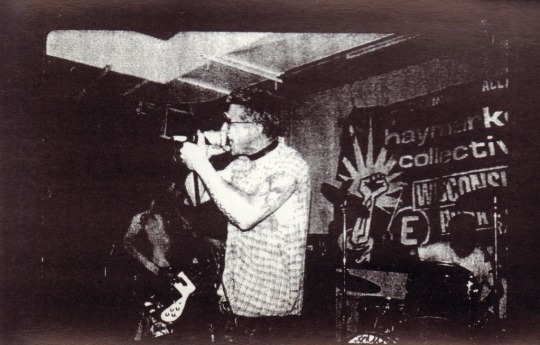
There’s just something really endearing about this grainy picture of this nerdy-looking dude with arm tattoos playing in front of a sign that says “haymarket collective” and has a fist and a circle E. Makes me happy inside.
Expect a new post in maybe two weeks? I’m not sure exactly how long time everything takes yet
1 note
·
View note
Text
Why You Should Read: The Anomaly

Introduction & Disclaimers
The Anomaly, by Coffeelemental, is simultaneously the "Saturday Morning Cartoon of Undertale sequels" and the Sistine Chapel of Undertale fan comics in its tone, dedication, polish and detail.
(In this work, Frisk is referred to as “she”. As such, the review will refer to Frisk with corresponding pronouns. The comic also has a major character death, in case one really, really dislikes that. The following review may contain minor spoilers.)
Art

Few other comics compare to its consistent precision, polish, and detail. That said, The Anomaly's sheer amount of content (128 pages, five playable segments, several lore posts and a few animations) and dedication over the years (it started on June 19, 2016) makes the work incredible even among those few.
Its great attention to detail and polish is especially obvious because of all its human characters. Many find humans hard to draw properly: there are so many ways they can look “off”. Yet, even in the comic's relatively crude early pages, humans have perfect proportions and poses. More impressive still is how Coffeelemental draws perfect humanlike anatomy (e.g., humanlike hands) even for characters where she could easily dodge the challenge.

What the Sistine Chapel does not have: a before-and-after (left and right) comparison of turtles in business suits.
In short, The Anomaly is basically the Sistine Chapel of long-form Undertale comics. As Coffelemental points out herself, in the first fourteen pages quality and style varies. But she improves very quickly: there's a jump in quality at Page 9, and it just keeps getting better.
As per its realism/detail, characters look somewhat more biologically plausible and, for lack of a better word, more monstrous or bestial. Undyne has scales in some places, as well as (this may come as a shock) a nose, though in most shots her face is largely flat with slit-like nostrils like Lord Voldemort. (well, some fish do have tiny nostrils.)
Indeed, as impressive as it is, its stylistic approach is so unique it takes some time to get used to. Furthermore, it seems the sheer dedication to precision and detail has its downsides. In Coffeelemental’s first animation attempt, she had to slightly simplify and adjust the antagonists' designs just to make animation possible, and then she could only do it in choppy 15 FPS (frames per second).
While its overall quality is rather consistent, the style/format shifts in tone. Akin to the original Teen Titans' anime-like exaggerations, characters are drawn in a simple style for comic effect a few times.
One particularly stylish element is how Coffeelemental blends in-game mechanics (such as literal buttons) with a somewhat more realistic style and tone. Referencing how battles in Undertale are in black-and-white, the pages are monochrome when Frisk resolves conflicts. Indeed, as it’s revealed later, Frisk can only see in black-and-white ever since falling into the Underground.
Plot & Themes
“Frisk is using her personal control of the timeline to ensure monsters have a peaceful return to the surface world – but the seven who sealed them underground in the first place have some problems with this.” - The Anomaly’s About page
It's clear The Anomaly's plot is carefully planned out, as is suitable for a work of its length. That most of the work takes place after an eight-year time skip, its mentions of other timelines, and its timeline-jumping might seem like risks to a simple, comprehensible plot: it's certainly complicated other works' plots. Nonetheless, in The Anomaly these are kept balanced, leading to a plot that's the perfect blend of simplicity and complexity.

(Pre-game foreshadowing, from this page. If one looks closely, the brown goat has barely visible pink blush stickers...just like Chara. Art by Coffeelemental)
In the comic itself as well as the game, there's foreshadowing aplenty---even for the events of the game itself. One of the playable segments is even an entertaining flashback sequence in itself.
Sometimes consequences are delayed across pages; characters make plans to deal with other characters later. Given the antagonists are immune to reload-related memory loss just like Frisk, they must resort to stealth, trickery and subterfuge when interacting with her.
As befitting a work with several immortal characters, it has extensive historical lore, contextualizing the human-monster conflict and immortal characters' motives. One piece of lore even neatly resolves one big problem in the game’s background: if humans can’t use magic, how did “humanity’s seven greatest magicians” create the Barrier?
The story brings up intriguing questions and mysteries. Why are monsters losing access to their magic? What is the mysterious thing connected to Frisk? Some have been resolved at time of writing, and others have been resolved in a fascinating way that just leads to more intrigue.
While some of The Anomaly's themes (e.g., "With great power [over time] comes great responsibility") are pretty common in Undertale works with a Frisk-based, Post-Pacifist timeline premise, The Anomaly nonetheless deals with those themes in an interesting way. Its biggest theme is "Are you [Frisk] strong enough to protect humanity?"
The theme is manifold. Frisk feels obligated to protect monsters (and humans) from human-monster conflicts, but a secret confidant worries the pressure of her role is mentally running her ragged. Then there's moral strength: as the antagonists fear, despite her goody-two-shoes persona Frisk has used her power for evil, selfish, frivolous or just silly ends a few times. (e.g., flirts and jokes backfiring and leaving others aghast)
Characterization
The characterization is so widespread, so outstanding, that the reviewer figuratively can’t say enough good things about it. (But, literally, will have to do so, or this post will get awfully long)
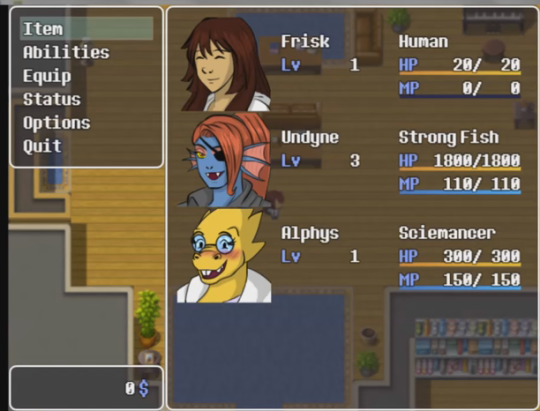
From the first playable part. Note Undyne's higher LV. Also note she eventually joined the U.S. Coast Guard (which is technically military) here sometime eight years after the Pacifist ending, so whether she gained the LV then or earlier is ambiguous.
Characters from the game itself hew closely to their original, nuanced personalities. (This is especially remarkable for Sans, given how often his character is distorted or misinterpreted in the fandom.) It pays attention to even tiny, easily-missed quirks and variations, such as the fact Sans always takes Frisk out to eat before a serious talk (Genocide Route aside) and Undyne’s military(-esque) background and combative nature. Like in-game, characters have “portraits” when talking in the playable segments, but these ones are small full-color digital paintings with a wide array of expressions.
Many works give Frisk an undefined or pretty bland personality and background. That's easy to do, given Frisk's ever-neutral expression, rare and indirect dialogue, and only faint hints of personal preferences. Yet, in The Anomaly, Coffeelemental made the rare choice of giving Frisk a particular ethnicity and background, vague it is. (Her entire pre-Underground backstory is told within two pages) It contextualizes why Frisk was such a goody two-shoes pacifist from an early age, that one (spoilers) timeline deviation aside.
Speaking of Frisk's friendly and pacifistic ways, while Frisk is indeed as described, it's not her whole personality. Though playful, flirty and, well, “frisky”, she feels responsible for the safety and happiness of a people she brought above-ground, and has kept her role as a “time-space hero” secret. Her duty has made her something of a control freak; after a major character death she rewinds time to prevent the most minor of conflicts. But that absolute control over the timeline may yet corrupt her: she selfishly reloaded just to fix a bad grade on a test.
The Anomaly is impressive not only for its seven antagonists at once working together, but for them all having distinct personalities, approaches, and relationships with each other. Though they broadly agree on particular courses of actions, their motives and level of monster sympathy differ. Regardless of their species, it's remarkable just how humanized they are as villains.
Playable Sections
At a few points in The Anomaly, Coffeelemental chooses to convey the story in a way that is “hopefully more fun and more practical than using a comic format”. Namely, in playable downloadable games.
At time of writing, it has five playable sections. While the reviewer, unfortunately, cannot play the playable sections (the reviewer's computer is rather old), I’ve seen playthroughs on YouTube. The level of characterization, worldbuilding and general atmosphere in this playable segments are excellent. It adds lovely details that simply wouldn’t fit into a comic within a playable narrative.
The author says she’s chosen speed over polish for the sake of regular updates; nonetheless, they are impressive. Four of these sections even have a turn-based battle system, and two are so in-depth they take an hour to fully explore.
Coffeelemental says she tried really hard to emulate Toby Fox’s style and sense of humor...and she succeeded. The quirks and jokes in things like item descriptions would fit right in. Indeed, when looking out the window in the first playable section, one gets the famous phrase “It’s beautiful day outside”, in a non-threatening context, long before Toby Fox did the same thing in Deltarune.
While Coffeelemental didn’t make the music for these segments, she nonetheless curated the music for the playable segments well. Often music from Undertale is used, but for situations where Toby Fox’s music doesn’t suit the situation, she’s contacted composers.
Conclusion
This gem of a multimedia work seems rather under-appreciated on Tumblr itself, or even its dedicated YouTube channel. Truly, it boggles the mind to wonder how a long-running work of such quality could stay obscure.
168 notes
·
View notes
Text
Carnegie Mellon is Saving Old Software from Oblivion
A prototype archiving system called Olive lets vintage code run on today’s computers
.carousel-inner{ height:525px !important; }
Illustration: Nicholas Little
In early 2010, Harvard economists Carmen Reinhart and Kenneth Rogoff published an analysis of economic data from many countries and concluded that when debt levels exceed 90 percent of gross national product, a nation’s economic growth is threatened. With debt that high, expect growth to become negative, they argued.
This analysis was done shortly after the 2008 recession, so it had enormous relevance to policymakers, many of whom were promoting high levels of debt spending in the interest of stimulating their nations’ economies. At the same time, conservative politicians, such as Olli Rehn, then an EU commissioner, and U.S. congressman Paul Ryan, used Reinhart and Rogoff’s findings to argue for fiscal austerity.
Three years later, Thomas Herndon, a graduate student at the University of Massachusetts, discovered an error in the Excel spreadsheet that Reinhart and Rogoff had used to make their calculations. The significance of the blunder was enormous: When the analysis was done properly, Herndon showed, debt levels in excess of 90 percent were associated with average growth of positive 2.2 percent, not the negative 0.1 percent that Reinhart and Rogoff had found.
Herndon could easily test the Harvard economists’ conclusions because the software that they had used to calculate their results—Microsoft Excel—was readily available. But what about much older findings for which the software originally used is hard to come by?
You might think that the solution—preserving the relevant software for future researchers to use—should be no big deal. After all, software is nothing more than a bunch of files, and those files are easy enough to store on a hard drive or on tape in digital format. For some software at least, the all-important source code could even be duplicated on paper, avoiding the possibility that whatever digital medium it’s written to could become obsolete.
Saving old programs in this way is done routinely, even for decades-old software. You can find online, for example, a full program listing for the Apollo Guidance Computer—code that took astronauts to the moon during the 1960s. It was transcribed from a paper copy and uploaded to GitHub in 2016.
While perusing such vintage source code might delight hard-core programmers, most people aren’t interested in such things. What they want to do is use the software. But keeping software in ready-to-run form over long periods of time is enormously difficult, because to be able to run most old code, you need both an old computer and an old operating system.
You might have faced this challenge yourself, perhaps while trying to play a computer game from your youth. But being unable to run an old program can have much more serious repercussions, particularly for scientific and technical research.
Along with economists, many other researchers, including physicists, chemists, biologists, and engineers, routinely use software to slice and dice their data and visualize the results of their analyses. They simulate phenomena with computer models that are written in a variety of programming languages and that use a wide range of supporting software libraries and reference data sets. Such investigations and the software on which they are based are central to the discovery and reporting of new research results.
Imagine that you’re an investigator and want to check calculations done by another researcher 25 years ago. Would the relevant software still be around? The company that made it may have disappeared. Even if a contemporary version of the software exists, will it still accept the format of the original data? Will the calculations be identical in every respect—for example, in the handling of rounding errors—to those obtained using a computer of a generation ago? Probably not.
Researchers’ growing dependence on computers and the difficulty they encounter when attempting to run old software are hampering their ability to check published results. The problem of obsolescent software is thus eroding the very premise of reproducibility—which is, after all, the bedrock of science.
The issue also affects matters that could be subject to litigation. Suppose, for example, that an engineer’s calculations show that a building design is robust, but the roof of that building nevertheless collapses. Did the engineer make a mistake, or was the software used for the calculations faulty? It would be hard to know years later if the software could no longer be run.
That’s why my colleagues and I at Carnegie Mellon University, in Pittsburgh, have been developing ways to archive programs in forms that can be run easily today and into the future. My fellow computer scientists Benjamin Gilbert and Jan Harkes did most of the required coding. But the collaboration has also involved software archivist Daniel Ryan and librarians Gloriana St. Clair, Erika Linke, and Keith Webster, who naturally have a keen interest in properly preserving this slice of modern culture.
Bringing Back Yesterday’s Software
The Olive system has been used to create 17 different virtual machines that run a variety of old software, some serious, some just for fun. Here are several views from those archived applications
1/8
NCSA Mosaic 1.0, a pioneering Web browser for the Macintosh from 1993.
2/8
Chaste (Cancer, Heart and Soft Tissue Environment) 3.1 for Linux from 2013.
<img src="https://spectrum.ieee.org/image/MzEzMTUzMg.jpeg" data-original="/image/MzEzMTUzMg.jpeg" id="618441086_2" alt="The Oregon Trail 1.1, a game for the Macintosh from 1990.”> 3/8
The Oregon Trail 1.1, a game for the Macintosh from 1990.
<img src="https://spectrum.ieee.org/image/MzEzMTUzNQ.jpeg" data-original="/image/MzEzMTUzNQ.jpeg" id="618441086_3" alt="Wanderer, a game for MS-DOS from 1988.”> 4/8
Wanderer, a game for MS-DOS from 1988.
<img src="https://spectrum.ieee.org/image/MzEzMTU1MA.jpeg" data-original="/image/MzEzMTU1MA.jpeg" id="618441086_4" alt="Mystery House, a game for the Apple II from 1982.”> 5/8
Mystery House, a game for the Apple II from 1982.
6/8
The Great American History Machine, an educational interactive atlas for Windows 3.1 from 1991.
7/8
Microsoft Office 4.3 for Windows 3.1 from 1994.
8/8
ChemCollective, educational chemistry software for Linux from 2013.
$(document).ready(function(){ $(‘#618441086’).carousel({ pause: true, interval: false }); });
Because this project is more one of archival preservation than mainstream computer science, we garnered financial support for it not from the usual government funding agencies for computer science but from the Alfred P. Sloan Foundation and the Institute for Museum and Library Services. With that support, we showed how to reconstitute long-gone computing environments and make them available online so that any computer user can, in essence, go back in time with just a click of the mouse.
We created a system called Olive—an acronym for Open Library of Images for Virtualized Execution. Olive delivers over the Internet an experience that in every way matches what you would have obtained by running an application, operating system, and computer from the past. So once you install Olive, you can interact with some very old software as if it were brand new. Think if it as a Wayback Machine for executable content.
To understand how Olive can bring old computing environments back to life, you have to dig through quite a few layers of software abstraction. At the very bottom is the common base of much of today’s computer technology: a standard desktop or laptop endowed with one or more x86 microprocessors. On that computer, we run the Linux operating system, which forms the second layer in Olive’s stack of technology.
Sitting immediately above the operating system is software written in my lab called VMNetX, for Virtual Machine Network Execution. A virtual machine is a computing environment that mimics one kind of computer using software running on a different kind of computer. VMNetX is special in that it allows virtual machines to be stored on a central server and then executed on demand by a remote system. The advantage of this arrangement is that your computer doesn’t need to download the virtual machine’s entire disk and memory state from the server before running that virtual machine. Instead, the information stored on disk and in memory is retrieved in chunks as needed by the next layer up: the virtual-machine monitor (also called a hypervisor), which can keep several virtual machines going at once.
Each one of those virtual machines runs a hardware emulator, which is the next layer in the Olive stack. That emulator presents the illusion of being a now-obsolete computer—for example, an old Macintosh Quadra with its 1990s-era Motorola 68040 CPU. (The emulation layer can be omitted if the archived software you want to explore runs on an x86-based computer.)
The next layer up is the old operating system needed for the archived software to work. That operating system has access to a virtual disk, which mimics actual disk storage, providing what looks like the usual file system to still-higher components in this great layer cake of software abstraction.
Above the old operating system is the archived program itself. This may represent the very top of the heap, or there could be an additional layer, consisting of data that must be fed to the archived application to get it to do what you want.
The upper layers of Olive are specific to particular archived applications and are stored on a central server. The lower layers are installed on the user’s own computer in the form of the Olive client software package. When you launch an archived application, the Olive client fetches parts of the relevant upper layers as needed from the central server.
Illustration: Nicholas Little
Layers of Abstraction: Olive requires many layers of software abstraction to create a suitable virtual machine. That virtual machine then runs the old operating system and application.
That’s what you’ll find under the hood. But what can Olive do? Today, Olive consists of 17 different virtual machines that can run a variety of operating systems and applications. The choice of what to include in that set was driven by a mix of curiosity, availability, and personal interests. For example, one member of our team fondly remembered playing The Oregon Trail when he was in school in the early 1990s. That led us to acquire an old Mac version of the game and to get it running again through Olive. Once word of that accomplishment got out, many people started approaching us to see if we could resurrect their favorite software from the past.
The oldest application we’ve revived is Mystery House, a graphics-enabled game from the early 1980s for the Apple II computer. Another program is NCSA Mosaic, which people of a certain age might remember as the browser that introduced them to the wonders of the World Wide Web.
Olive provides a version of Mosaic that was written in 1993 for Apple’s Macintosh System 7.5 operating system. That operating system runs on an emulation of the Motorola 68040 CPU, which in turn is created by software running on an actual x86-based computer that runs Linux. In spite of all this virtualization, performance is pretty good, because modern computers are so much faster than the original Apple hardware.
Pointing Olive’s reconstituted Mosaic browser at today’s Web is instructive: Because Mosaic predates Web technologies such as JavaScript, HTTP 1.1, Cascading Style Sheets, and HTML 5, it is unable to render most sites. But you can have some fun tracking down websites composed so long ago that they still look just fine.
What else can Olive do? Maybe you’re wondering what tools businesses were using shortly after Intel introduced the Pentium processor. Olive can help with that, too. Just fire up Microsoft Office 4.3 from 1994 (which thankfully predates the annoying automated office assistant “Clippy”).
Perhaps you just want to spend a nostalgic evening playing Doom for DOS—or trying to understand what made such first-person shooter games so popular in the early 1990s. Or maybe you need to redo your 1997 taxes and can’t find the disk for that year’s version of TurboTax in your attic. Have no fear: Olive has you covered.
On the more serious side, Olive includes Chaste 3.1. The name of this software is short for Cancer, Heart and Soft Tissue Environment. It’s a simulation package developed at the University of Oxford for computationally demanding problems in biology and physiology. Version 3.1 of Chaste was tied to a research paper published in March 2013. Within two years of publication, though, the source code for Chaste 3.1 no longer compiled on new Linux releases. That’s emblematic of the challenge to scientific reproducibility Olive was designed to address.
Illustration: Nicholas Little
To keep Chaste 3.1 working, Olive provides a Linux environment that’s frozen in time. Olive’s re-creation of Chaste also contains the example data that was published with the 2013 paper. Running the data through Chaste produces visualizations of certain muscle functions. Future physiology researchers who wish to explore those visualizations or make modifications to the published software will be able to use Olive to edit the code on the virtual machine and then run it.
For now, though, Olive is available only to a limited group of users. Because of software-licensing restrictions, Olive’s collection of vintage software is currently accessible only to people who have been collaborating on the project. The relevant companies will need to give permissions to present Olive’s re-creations to broader audiences.
We are not alone in our quest to keep old software alive. For example, the Internet Archive is preserving thousands of old programs using an emulation of MS-DOS that runs in the user’s browser. And a project being mounted at Yale, called EaaSI (Emulation as a Service Infrastructure), hopes to make available thousands of emulated software environments from the past. The scholars and librarians involved with the Software Preservation Network have been coordinating this and similar efforts. They are also working to address the copyright issues that arise when old software is kept running in this way.
Olive has come a long way, but it is still far from being a fully developed system. In addition to the problem of restrictive software licensing, various technical roadblocks remain.
One challenge is how to import new data to be processed by an old application. Right now, such data has to be entered manually, which is both laborious and error prone. Doing so also limits the amount of data that can be analyzed. Even if we were to add a mechanism to import data, the amount that could be saved would be limited to the size of the virtual machine’s virtual disk. That may not seem like a problem, but you have to remember that the file systems on older computers sometimes had what now seem like quaint limits on the amount of data they could store.
Another hurdle is how to emulate graphics processing units (GPUs). For a long while now, the scientific community has been leveraging the parallel-processing power of GPUs to speed up many sorts of calculations. To archive executable versions of software that takes advantage of GPUs, Olive would need to re-create virtual versions of those chips, a thorny task. That’s because GPU interfaces—what gets input to them and what they output—are not standardized.
Clearly there’s quite a bit of work to do before we can declare that we have solved the problem of archiving executable content. But Olive represents a good start at creating the kinds of systems that will be required to ensure that software from the past can live on to be explored, tested, and used long into the future.
This article appears in the October 2018 print issue as “Saving Software From Oblivion.”
About the Author
Mahadev Satyanarayanan is a professor of computer science at Carnegie Mellon University, in Pittsburgh.
Carnegie Mellon is Saving Old Software from Oblivion syndicated from https://jiohowweb.blogspot.com
3 notes
·
View notes